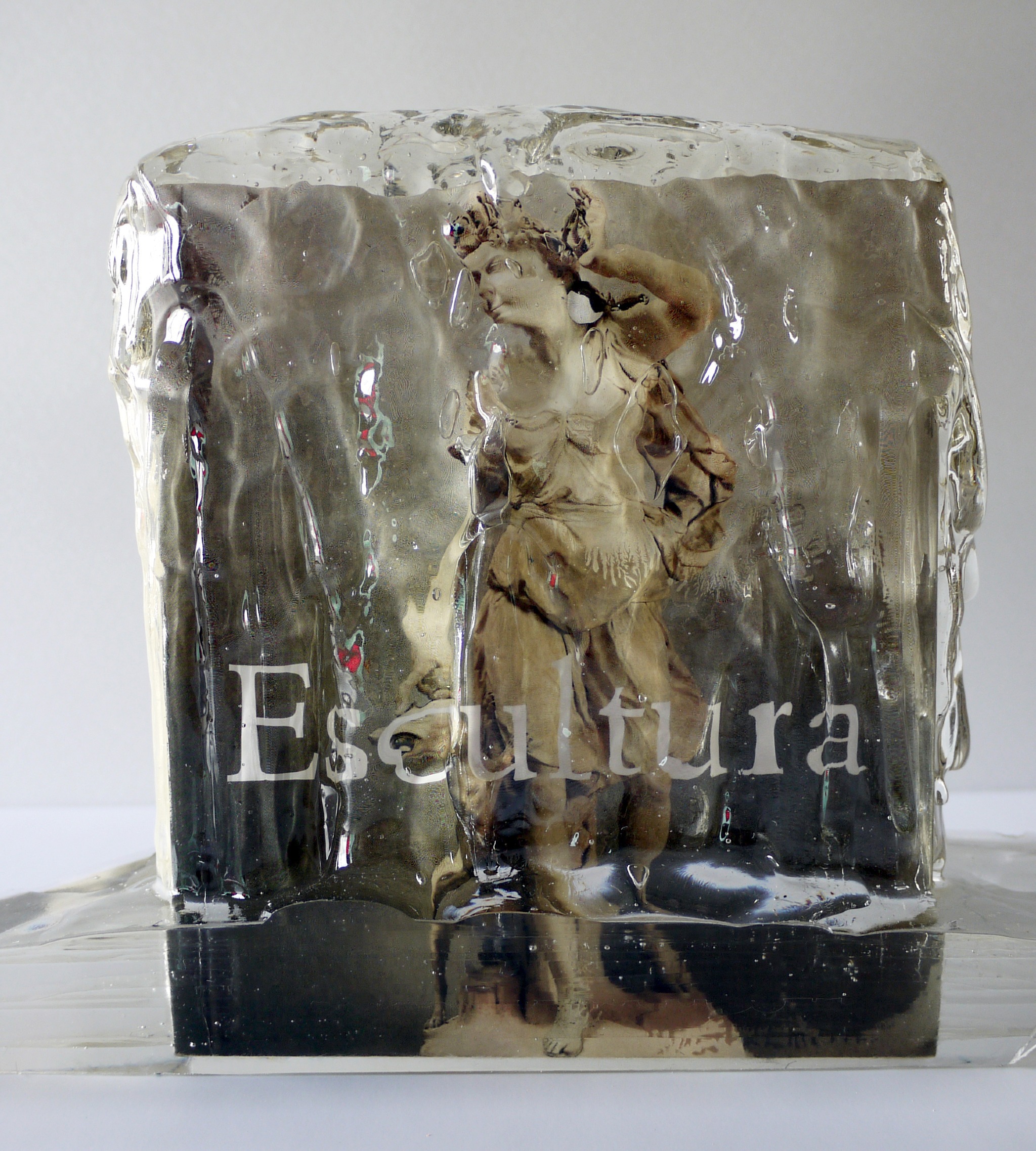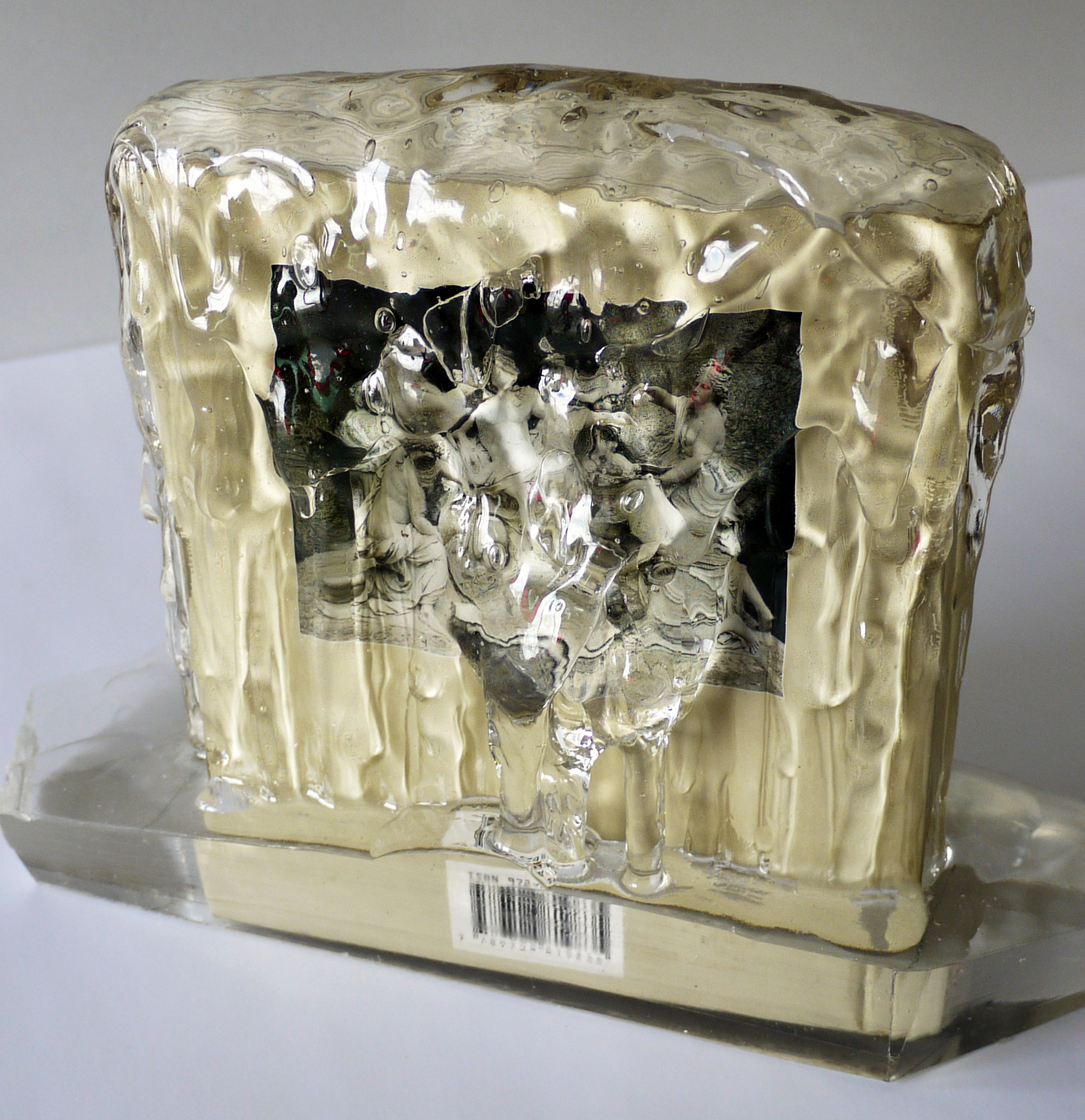desmanches

tendências da escultura moderna
tendencies in modern sculpture]
intervenção em livro
sliced book
24x31cm
Tropeçavas nos astros desastrada
Quase não tínhamos livros em casa
E a cidade não tinha livraria
Mas os livros que em nossa vida entraram
São como a radiação de um corpo negro
Apontando pra a expansão do Universo
Porque a frase, o conceito, o enredo, o verso
(E, sem dúvida, sobretudo o verso)
É o que pode lançar mundos no mundo.
Tropeçavas nos astros desastrada
Sem saber que a ventura e a desventura
Dessa estrada que vai do nada ao nada
São livros e o luar contra a cultura.
Os livros são objetos transcendentes
Mas podemos amá-los do amor táctil
Que votamos aos maços de cigarro
Domá-los, cultivá-los em aquários,
Em estantes, gaiolas, em fogueiras
Ou lançá-los pra fora das janelas
(Talvez isso nos livre de lançarmo-nos)
Ou o
que é muito pior por
odiarmo-los
Podemos simplesmente escrever um:
Encher de vãs palavras muitas páginas
E de mais confusão as prateleiras.
Tropeçavas nos astros desastrada
Mas pra mim foste a estrela entre as estrelas.
[ Livros, Caetano Veloso ]
Quase não tínhamos livros em casa
E a cidade não tinha livraria
Mas os livros que em nossa vida entraram
São como a radiação de um corpo negro
Apontando pra a expansão do Universo
Porque a frase, o conceito, o enredo, o verso
(E, sem dúvida, sobretudo o verso)
É o que pode lançar mundos no mundo.
Tropeçavas nos astros desastrada
Sem saber que a ventura e a desventura
Dessa estrada que vai do nada ao nada
São livros e o luar contra a cultura.
Os livros são objetos transcendentes
Mas podemos amá-los do amor táctil
Que votamos aos maços de cigarro
Domá-los, cultivá-los em aquários,
Em estantes, gaiolas, em fogueiras
Ou lançá-los pra fora das janelas
(Talvez isso nos livre de lançarmo-nos)
Ou o
que é muito pior por
odiarmo-los
Podemos simplesmente escrever um:
Encher de vãs palavras muitas páginas
E de mais confusão as prateleiras.
Tropeçavas nos astros desastrada
Mas pra mim foste a estrela entre as estrelas.
[ Livros, Caetano Veloso ]
(portuguese texts below the images)
After a brief and vertiginous odd feeling one is able to see the precise gesture of Lucas Simões in the intervention he made in Walter Zanini’s book Tendências da Escultura Moderna [Modern Sculpture Trends] and, therefore, to generate its re-signification: a reading by means of dismantling. It took a diagonal cut and the shift of one of the resulting modules toward the book spine for the artist to re-coordinate both the volume of the book and the field of discourse to which his research refers. This rearrangement reaffirms and develops the first cut, which established the limits of the sides of the book and ensures that a scission is made in the center of the object. The book seems placed in perspective in the plane and the reading of its content is drastically discontinued by the interruption that crosses it entirely. Although symmetry is preserved, it is not
immediate or evident; on the contrary, the sharp-cornered forms create oscillation and discontinuity in our gaze. This lack of balance ensures an expressive charge to the arrangement, despite its geometric coherence and, in this sense, it reminds us of the compositional resources of some neo-concrete works, which aimed at expanding and even breaking some of the trends established in the formal vocabulary of modern art. Hélio Oiticica’s Metaesquemas, for example, witnessed, in the late 1950s, an effort to expand the structure of the modernist framework and include elements of subjectivity in the strict geometric vocabulary of concrete art to build a sensitive geometry that would be open to the influence of other fields that interpret the form. In these works, the balance achieved by the forms was established by means of unequal paths, interferences, detours and intervals in the orthogonal limits. An unpredicted dynamics and musicality emerged from this.
In Lucas Simões’s object-book there is a will to manipulate forms and re-articulate meanings as result of simple shifts that, nevertheless, reveal the critical dimension these elements may acquire in different situations. It is palpable the awareness that each element of the work -the diagonal cut, the formal re-composition of the volume, the appropriation of the book and its theme, the proposal of traversing its reading - is managed by the artist to potentialize its multiple semantic possibilities.
Between a critical (re)reading of the history of sculpture and ‘sculptural procedure, the cut that has been made intervenes both in the volume of the book and in its symbolical dimension, and, therefore, forms and proposes a strategy of apprehension and creative use of the resources made available by art history, particularly in the field of sculpture (which, by
the way, is the one in which the specificities of the medium were further expanded, obscured and questioned by the artists’ practice, specially after the mid-1960s). In this work, the art history discourse is actually understood as a materiality that can be intervened, shaped and presented again by the artist. Therefore, all the repertoires studied and analyzed by Walter Zanini in his book, from a conservative feature Zanini identifies in the late 19th-century sculpture to the most radical experiments integrated to the avant-garde spirit in the early 20th century, such as Duchamp’s readymade (whose resonance is perceived in the appropriation and rectification of the object coordinated by Lucas Simões), are brought to the reading the artist materializes in his work. Hence his understanding of form and gesture as critical discourse: reading by means of dismantling proposes to actively mobilize the legacy of art history, strengthening and promoting new possible readings of its records.
text by Julio Martins
part of the book "Collection: New Approaches, vol.2, MAC Essencial
Nearly thirty years after publication, a book on the history of modern sculpture is cut in half, and becomes part of this history.
Lucas Simões’s action emerges as a diagonal dry and quick cut that renews the two divided parts by transforming them in a different object By doing so, the artist extends and updates a gesture like Lucio Fontana’s, with his surgical and laconic rip that results in multiple meanings. But whereas in Fontana’s work the traditional artistic supports and art history are confronted, in Tendências da Escultura Moderna, in a complimentary manner, the statute of printed media in the digitalization era is included. The meanings of Tendências are also expanded because it belongs to the MAC USP collection: both because Walter Zanini, the author of the book, was the first director of the institution and because the book cover contains the sculpture of Max Bill and Umberto Boccioni, Tripartite Unity and Unique Forms of Continuity in Space, which are also part of the museum collection. We may also ask ourselves about the “chance” of the image of the man from Unique Forms be cut off because it is precisely placed at the point where the book was cut, and about the fact that its oblique walk
coincides with the formal generator of the new volume, giving impulse and continuity to it. Is it also a coincidence the fact that the geometry of this new volume evokes the Concretism of the years when Zanini wrote the book?
Being substantially ambiguous, Simões’ action goes beyond mere iconoclasm and becomes a legitimate Duchampian “child.” Its simplicity, beyond minimalism, is also manifested in the fact that the original title was kept, and the work becomes simultaneously a reverence and an overcoming. Penetrating as the blow that created it, Tendencias da Escultura Moderna does not need to be contemplated at length. But if the eye closes like a guillotine, it is possible to see its value, which is specially related with time. We only have to look at the white text block that emerges after the book is cut diagonally - it contrasts with the yellowish color of the sides - to understand that the years are indifferent and act upon everybody.
text by Alex Miyoshi
part of the book "Collection: New Approaches, vol.3, MAC Essencial
After a brief and vertiginous odd feeling one is able to see the precise gesture of Lucas Simões in the intervention he made in Walter Zanini’s book Tendências da Escultura Moderna [Modern Sculpture Trends] and, therefore, to generate its re-signification: a reading by means of dismantling. It took a diagonal cut and the shift of one of the resulting modules toward the book spine for the artist to re-coordinate both the volume of the book and the field of discourse to which his research refers. This rearrangement reaffirms and develops the first cut, which established the limits of the sides of the book and ensures that a scission is made in the center of the object. The book seems placed in perspective in the plane and the reading of its content is drastically discontinued by the interruption that crosses it entirely. Although symmetry is preserved, it is not
immediate or evident; on the contrary, the sharp-cornered forms create oscillation and discontinuity in our gaze. This lack of balance ensures an expressive charge to the arrangement, despite its geometric coherence and, in this sense, it reminds us of the compositional resources of some neo-concrete works, which aimed at expanding and even breaking some of the trends established in the formal vocabulary of modern art. Hélio Oiticica’s Metaesquemas, for example, witnessed, in the late 1950s, an effort to expand the structure of the modernist framework and include elements of subjectivity in the strict geometric vocabulary of concrete art to build a sensitive geometry that would be open to the influence of other fields that interpret the form. In these works, the balance achieved by the forms was established by means of unequal paths, interferences, detours and intervals in the orthogonal limits. An unpredicted dynamics and musicality emerged from this.
In Lucas Simões’s object-book there is a will to manipulate forms and re-articulate meanings as result of simple shifts that, nevertheless, reveal the critical dimension these elements may acquire in different situations. It is palpable the awareness that each element of the work -the diagonal cut, the formal re-composition of the volume, the appropriation of the book and its theme, the proposal of traversing its reading - is managed by the artist to potentialize its multiple semantic possibilities.
Between a critical (re)reading of the history of sculpture and ‘sculptural procedure, the cut that has been made intervenes both in the volume of the book and in its symbolical dimension, and, therefore, forms and proposes a strategy of apprehension and creative use of the resources made available by art history, particularly in the field of sculpture (which, by
the way, is the one in which the specificities of the medium were further expanded, obscured and questioned by the artists’ practice, specially after the mid-1960s). In this work, the art history discourse is actually understood as a materiality that can be intervened, shaped and presented again by the artist. Therefore, all the repertoires studied and analyzed by Walter Zanini in his book, from a conservative feature Zanini identifies in the late 19th-century sculpture to the most radical experiments integrated to the avant-garde spirit in the early 20th century, such as Duchamp’s readymade (whose resonance is perceived in the appropriation and rectification of the object coordinated by Lucas Simões), are brought to the reading the artist materializes in his work. Hence his understanding of form and gesture as critical discourse: reading by means of dismantling proposes to actively mobilize the legacy of art history, strengthening and promoting new possible readings of its records.
text by Julio Martins
part of the book "Collection: New Approaches, vol.2, MAC Essencial
Nearly thirty years after publication, a book on the history of modern sculpture is cut in half, and becomes part of this history.
Lucas Simões’s action emerges as a diagonal dry and quick cut that renews the two divided parts by transforming them in a different object By doing so, the artist extends and updates a gesture like Lucio Fontana’s, with his surgical and laconic rip that results in multiple meanings. But whereas in Fontana’s work the traditional artistic supports and art history are confronted, in Tendências da Escultura Moderna, in a complimentary manner, the statute of printed media in the digitalization era is included. The meanings of Tendências are also expanded because it belongs to the MAC USP collection: both because Walter Zanini, the author of the book, was the first director of the institution and because the book cover contains the sculpture of Max Bill and Umberto Boccioni, Tripartite Unity and Unique Forms of Continuity in Space, which are also part of the museum collection. We may also ask ourselves about the “chance” of the image of the man from Unique Forms be cut off because it is precisely placed at the point where the book was cut, and about the fact that its oblique walk
coincides with the formal generator of the new volume, giving impulse and continuity to it. Is it also a coincidence the fact that the geometry of this new volume evokes the Concretism of the years when Zanini wrote the book?
Being substantially ambiguous, Simões’ action goes beyond mere iconoclasm and becomes a legitimate Duchampian “child.” Its simplicity, beyond minimalism, is also manifested in the fact that the original title was kept, and the work becomes simultaneously a reverence and an overcoming. Penetrating as the blow that created it, Tendencias da Escultura Moderna does not need to be contemplated at length. But if the eye closes like a guillotine, it is possible to see its value, which is specially related with time. We only have to look at the white text block that emerges after the book is cut diagonally - it contrasts with the yellowish color of the sides - to understand that the years are indifferent and act upon everybody.
text by Alex Miyoshi
part of the book "Collection: New Approaches, vol.3, MAC Essencial
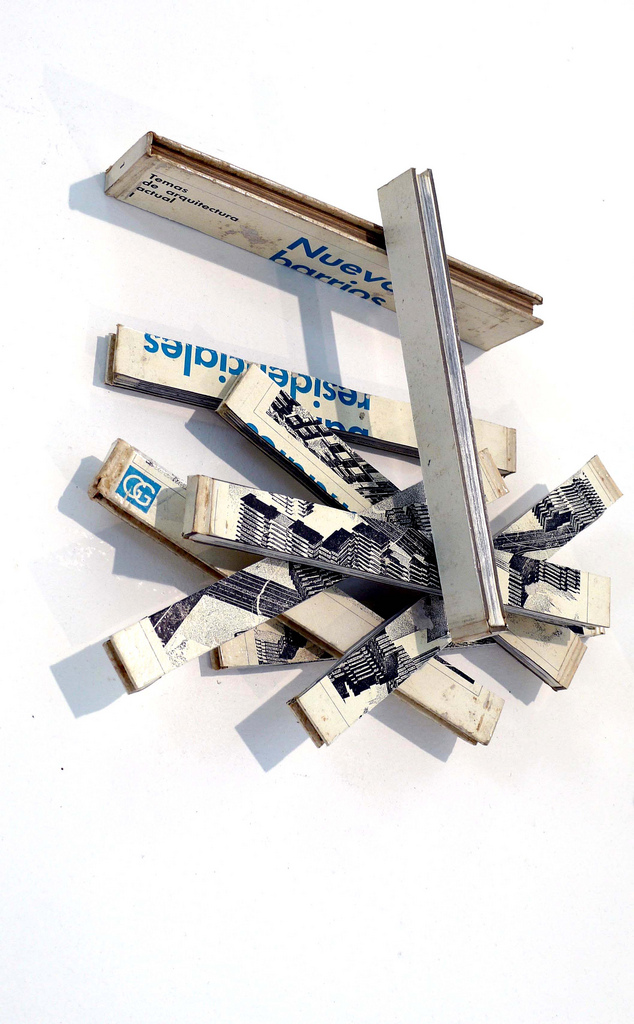
nuevos barrios residenciales
intervenção em livro
sliced book
variable [40 x 40 cm]
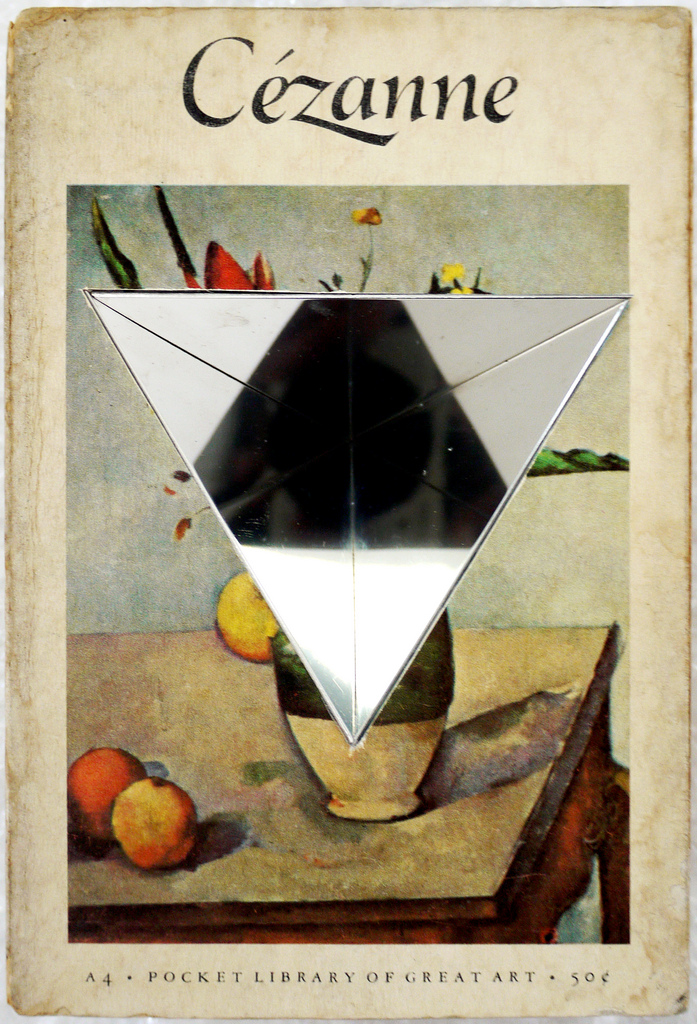
Les maîtres
intervenção em livro
sliced book and stainless steel
17 x 11,5 x 5,5 cm

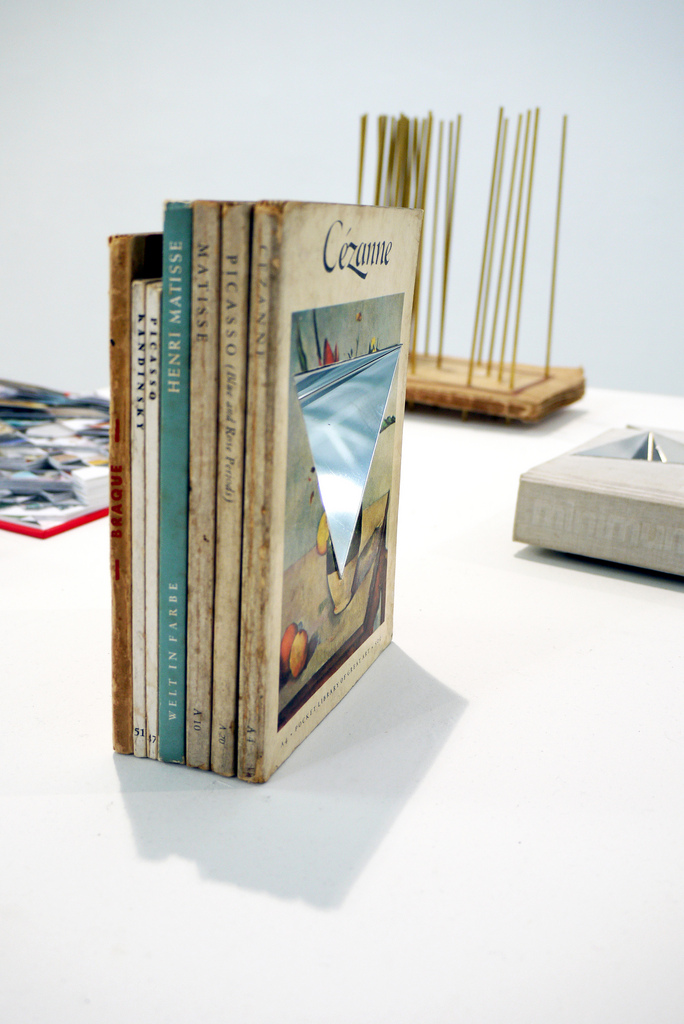
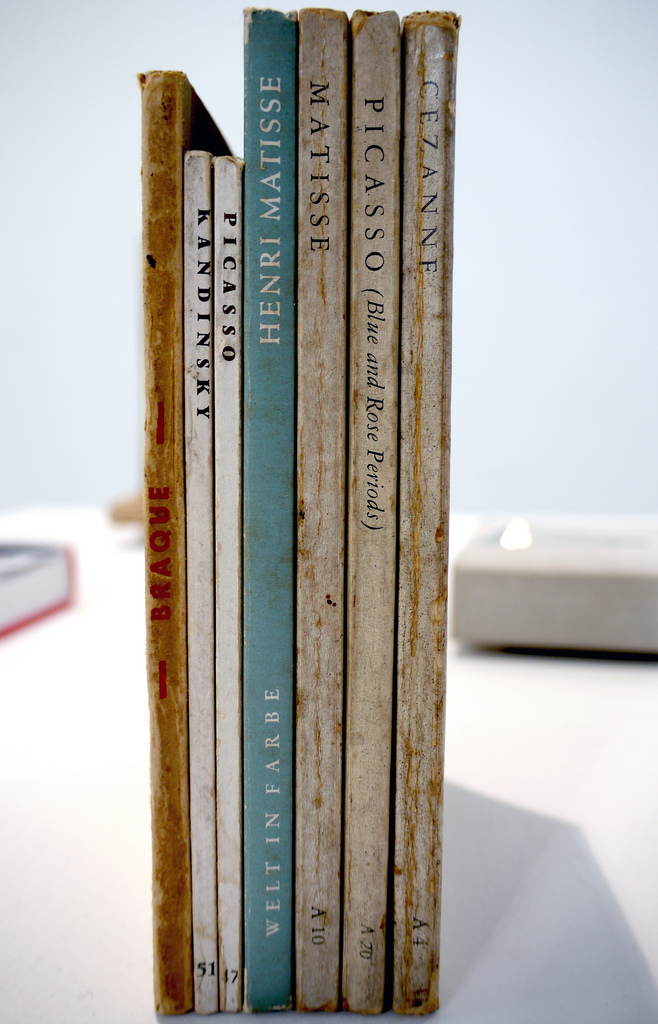
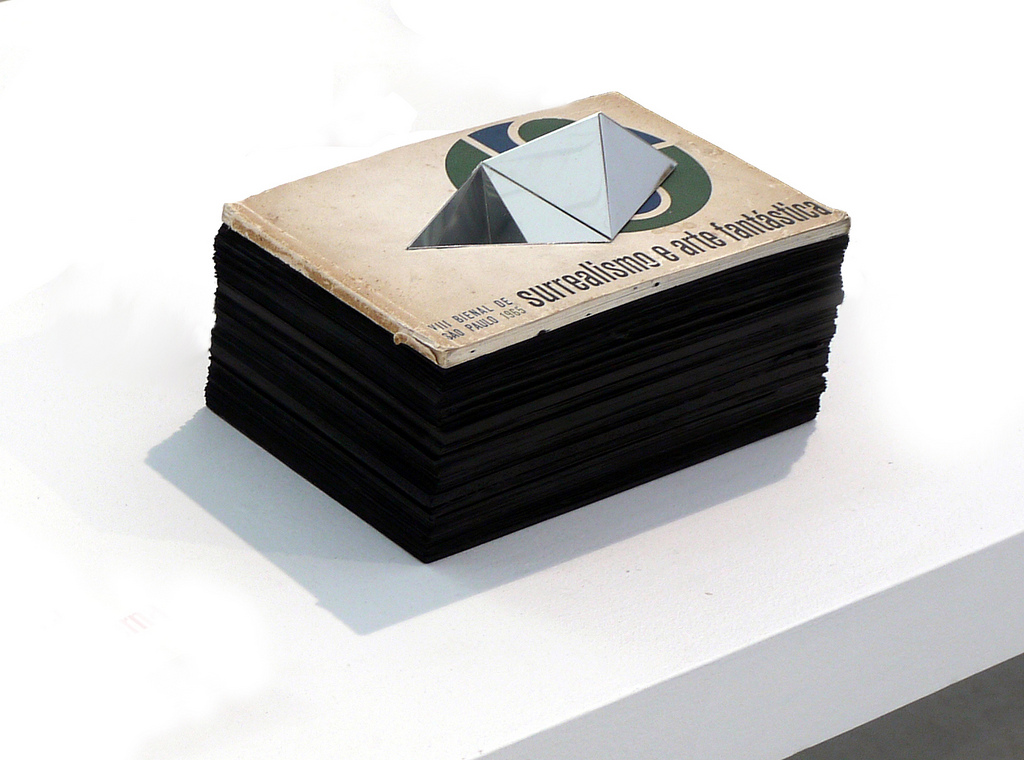
surrealismo e arte fantástica
surrealism and fantastic art
intervenção em livro
sliced book and stainless steel
17 x 25 x 15 cm

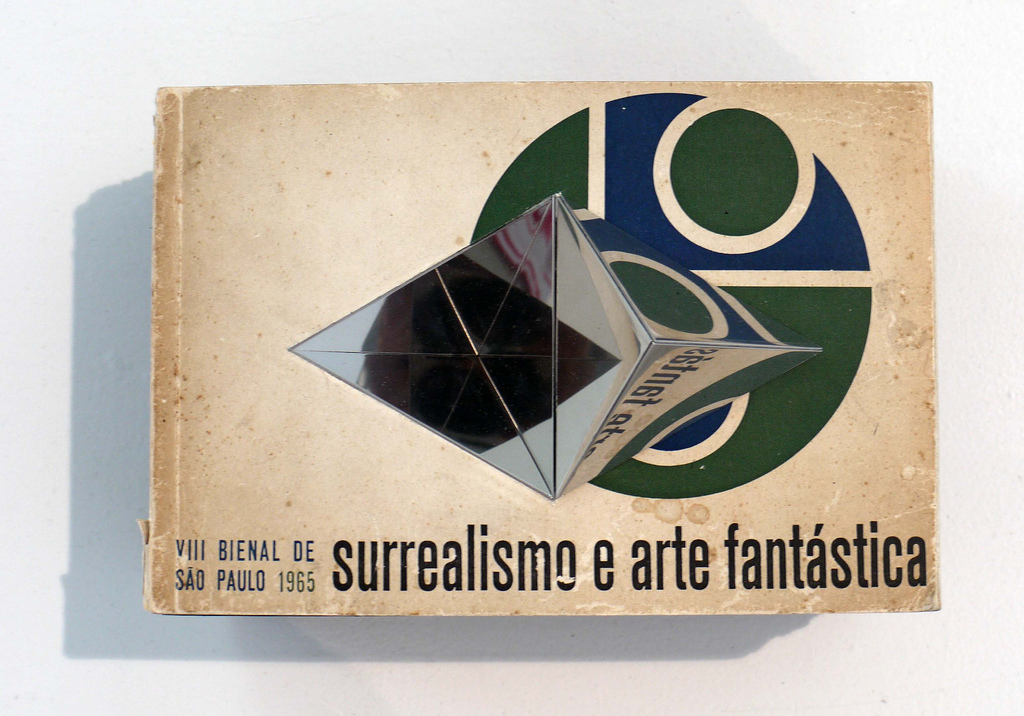
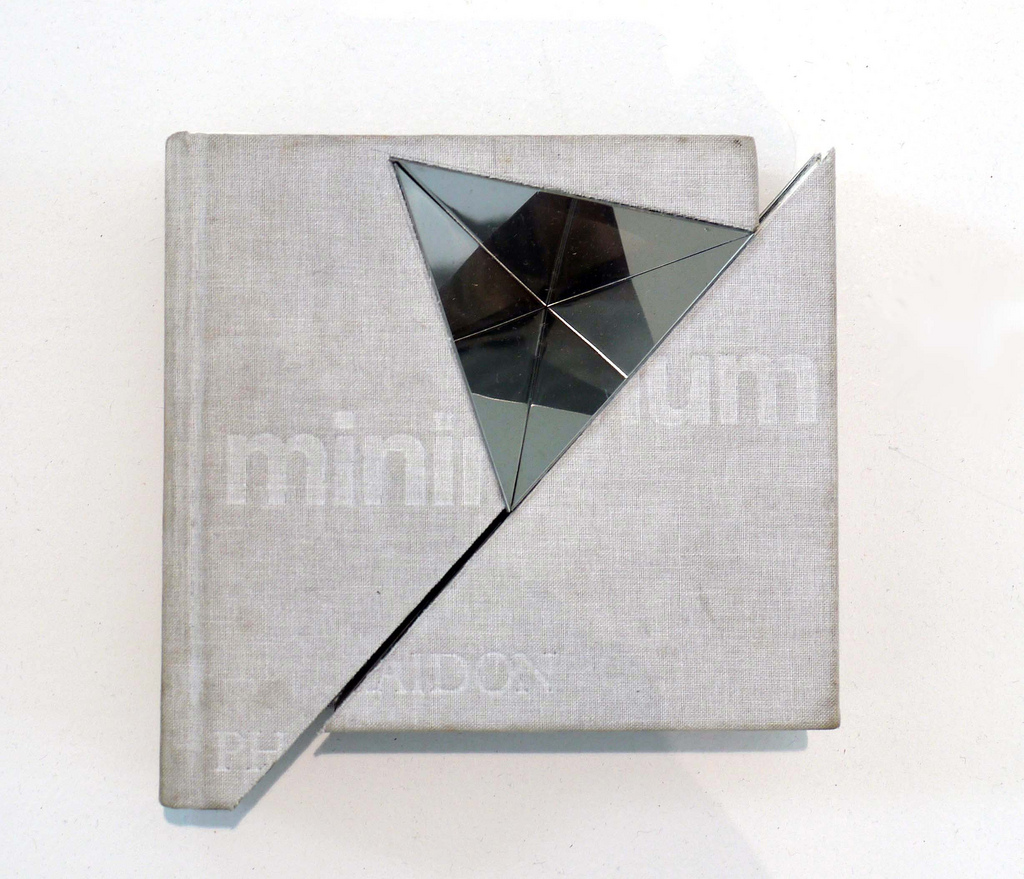
minimum
intervenção em livro
sliced book and stainless steel
16 x 18 cm
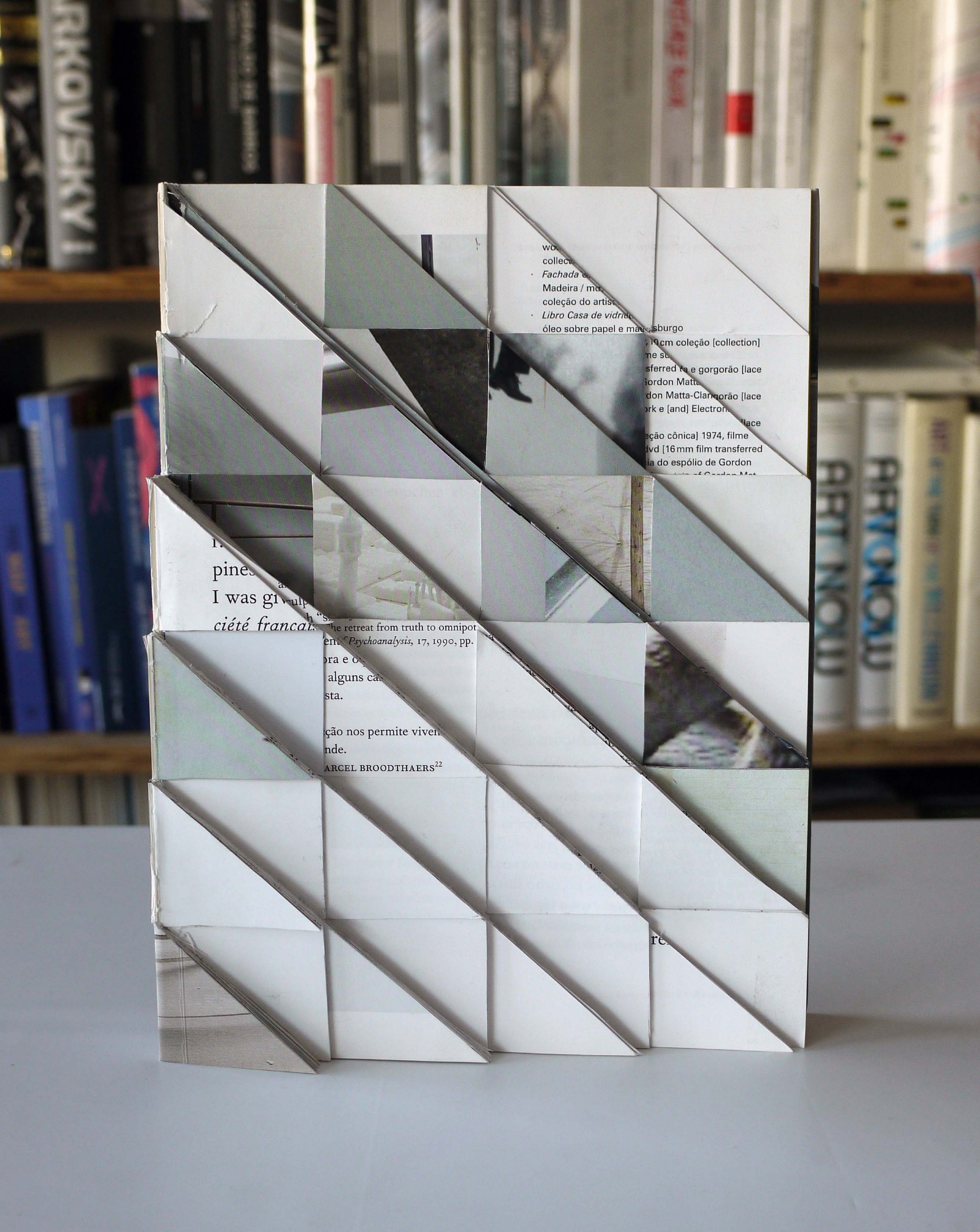
como viver junto [27a. Bienal de São Paulo]
how to live together [27a. Bienal de São Paulo]
intervenção em livro
cut-out book
24 x 18 cm



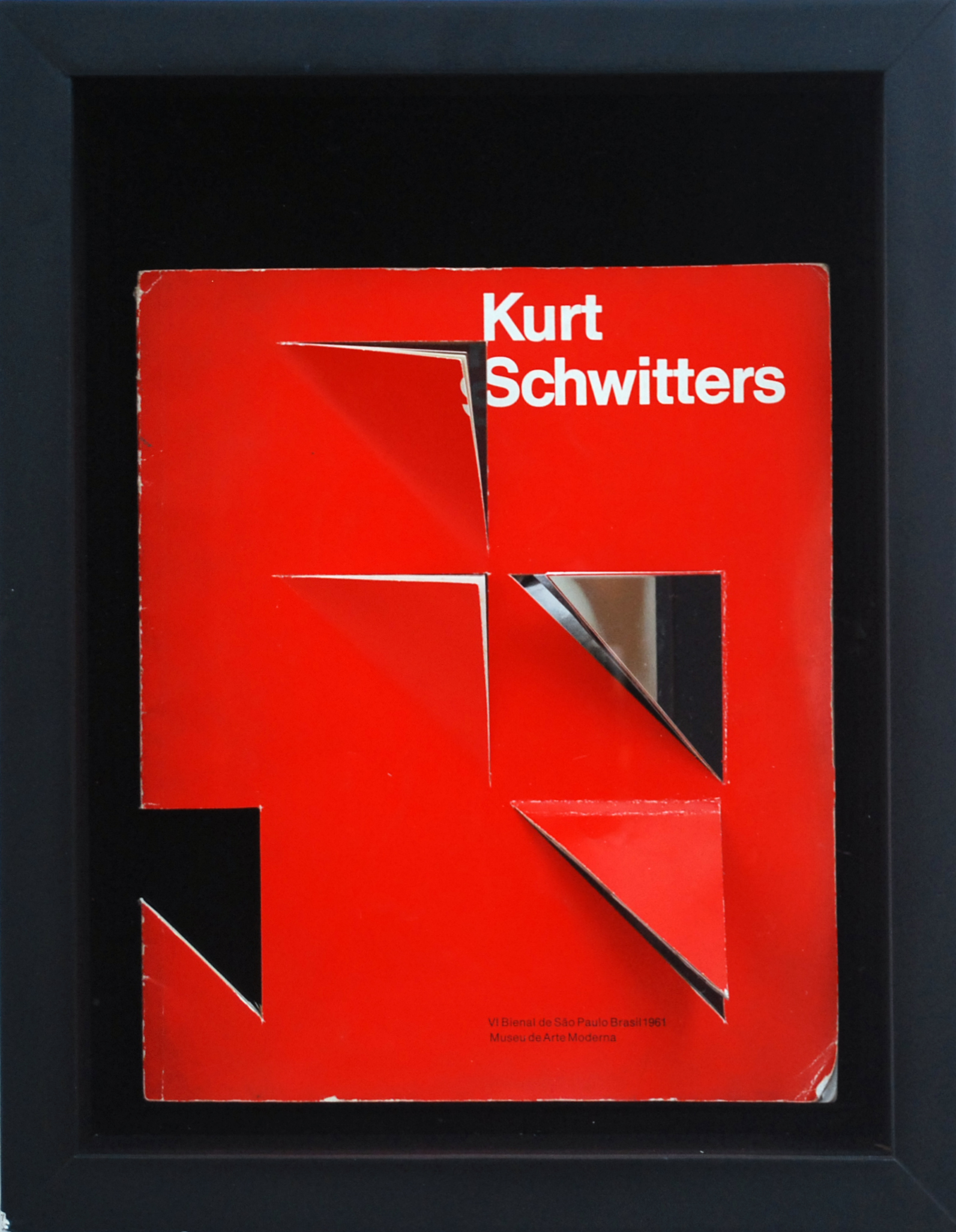
autorretrato [Kurt Schwitters], 2010
self-portrait [Kurt Schwitters], 2010
intervenção em livro
sliced book and stainless steel
36 x 28 cm
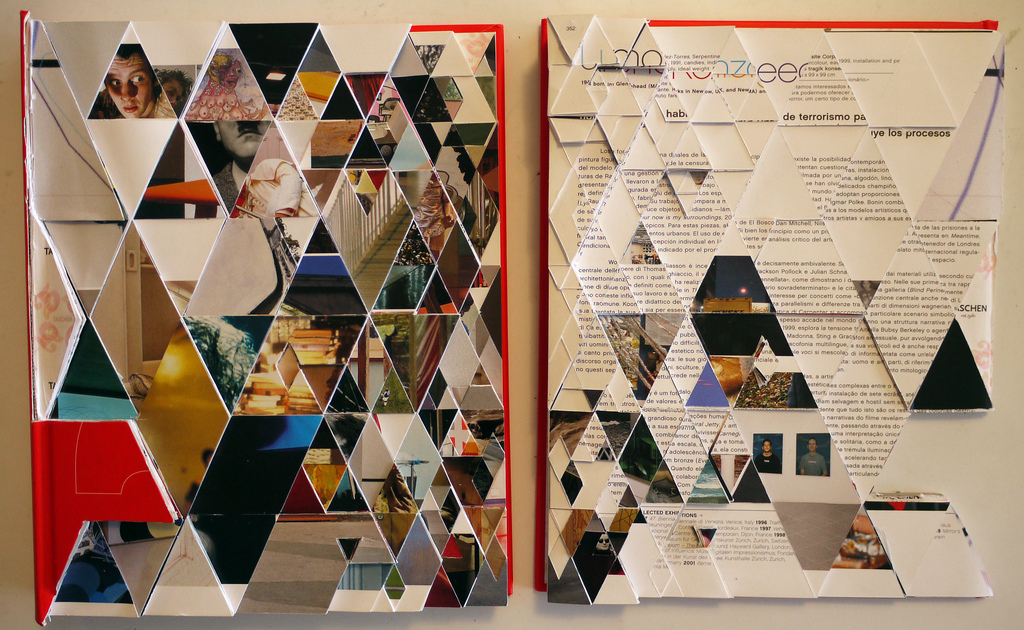
Art now!
intervenção em livro
cut-out book
48 x 37 cm

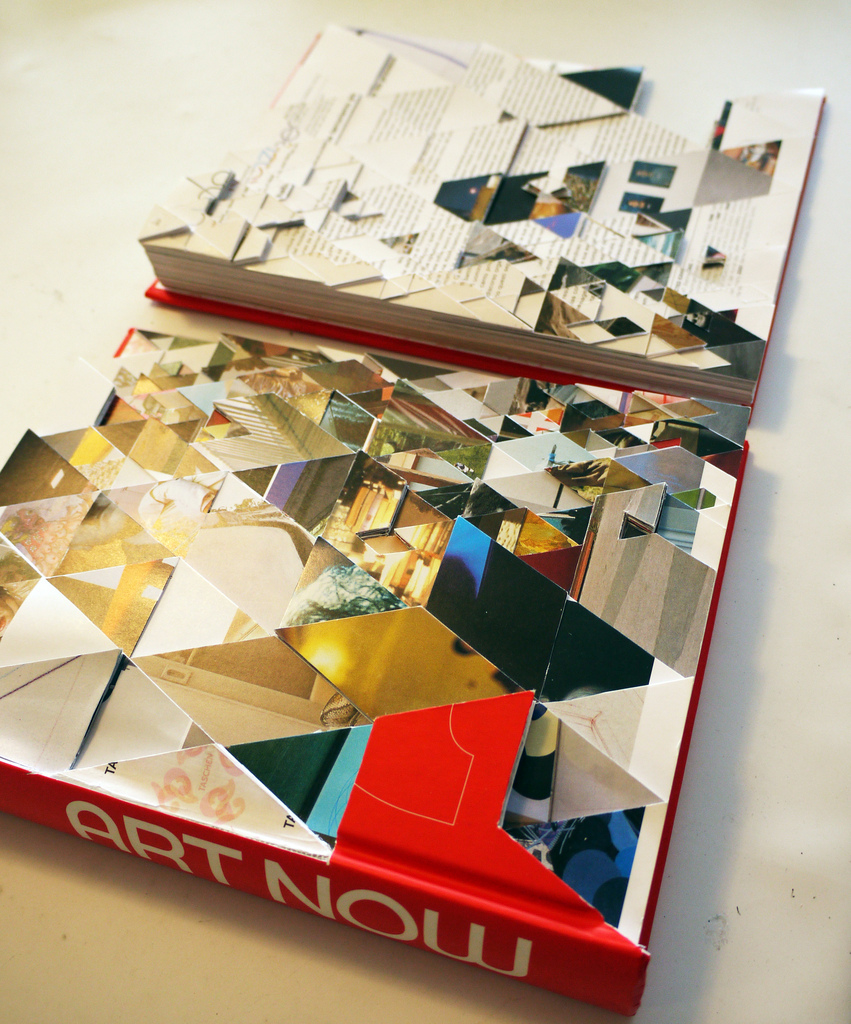
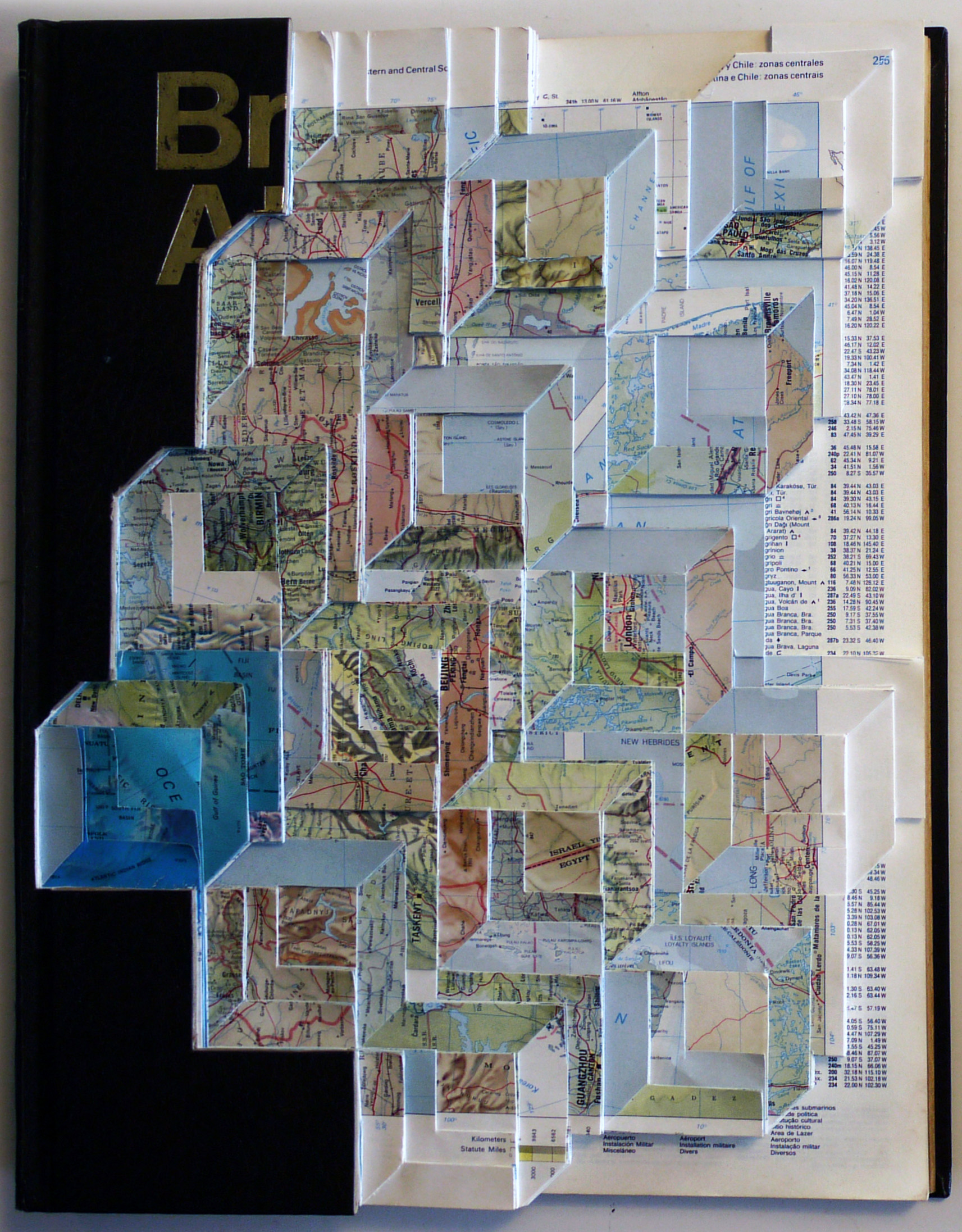
Britannica Atlas
intervenção em livro
cut-out book
38 x 29 cm

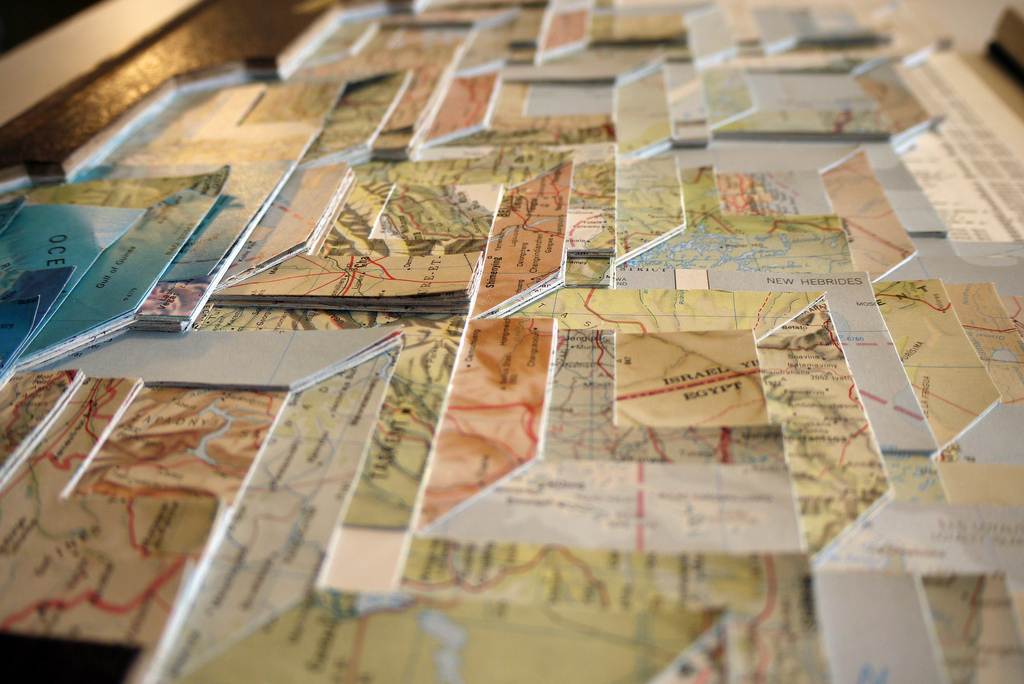
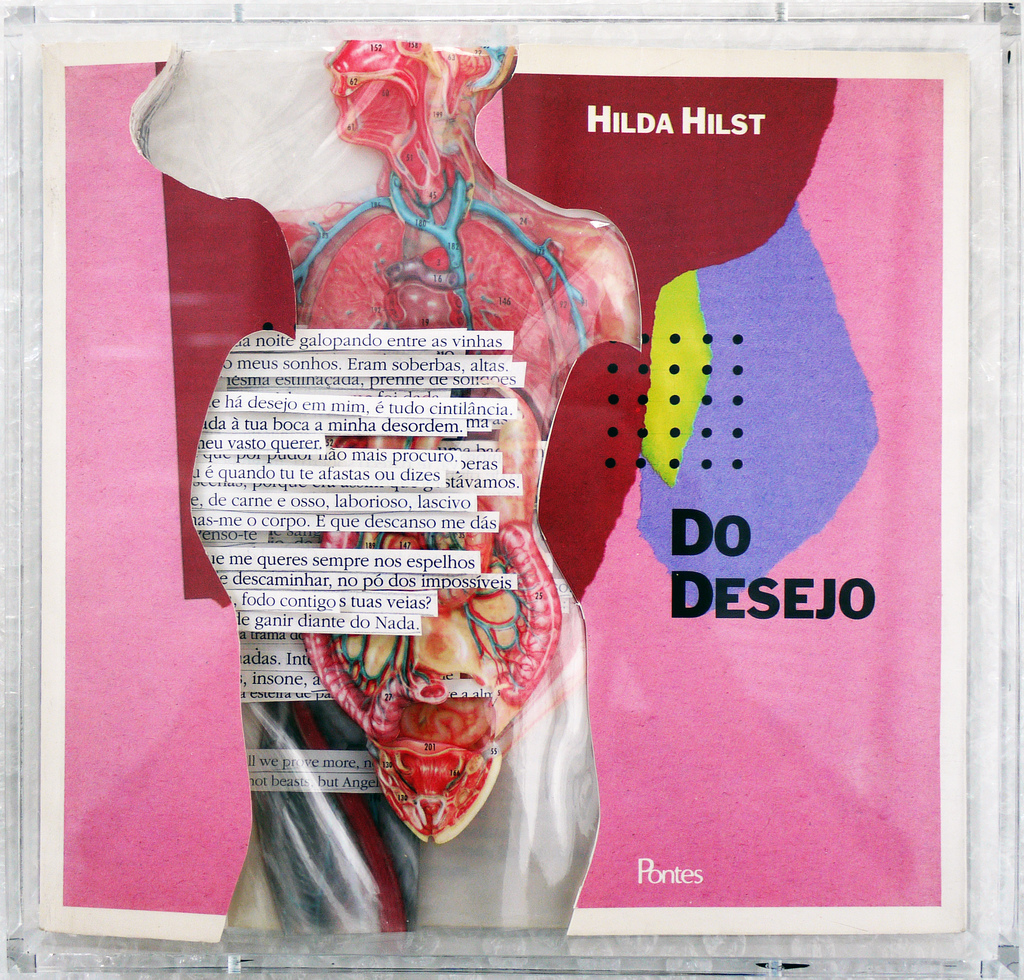
Do Desejo
intervenção em livro
sliced book
22 x 22 cm
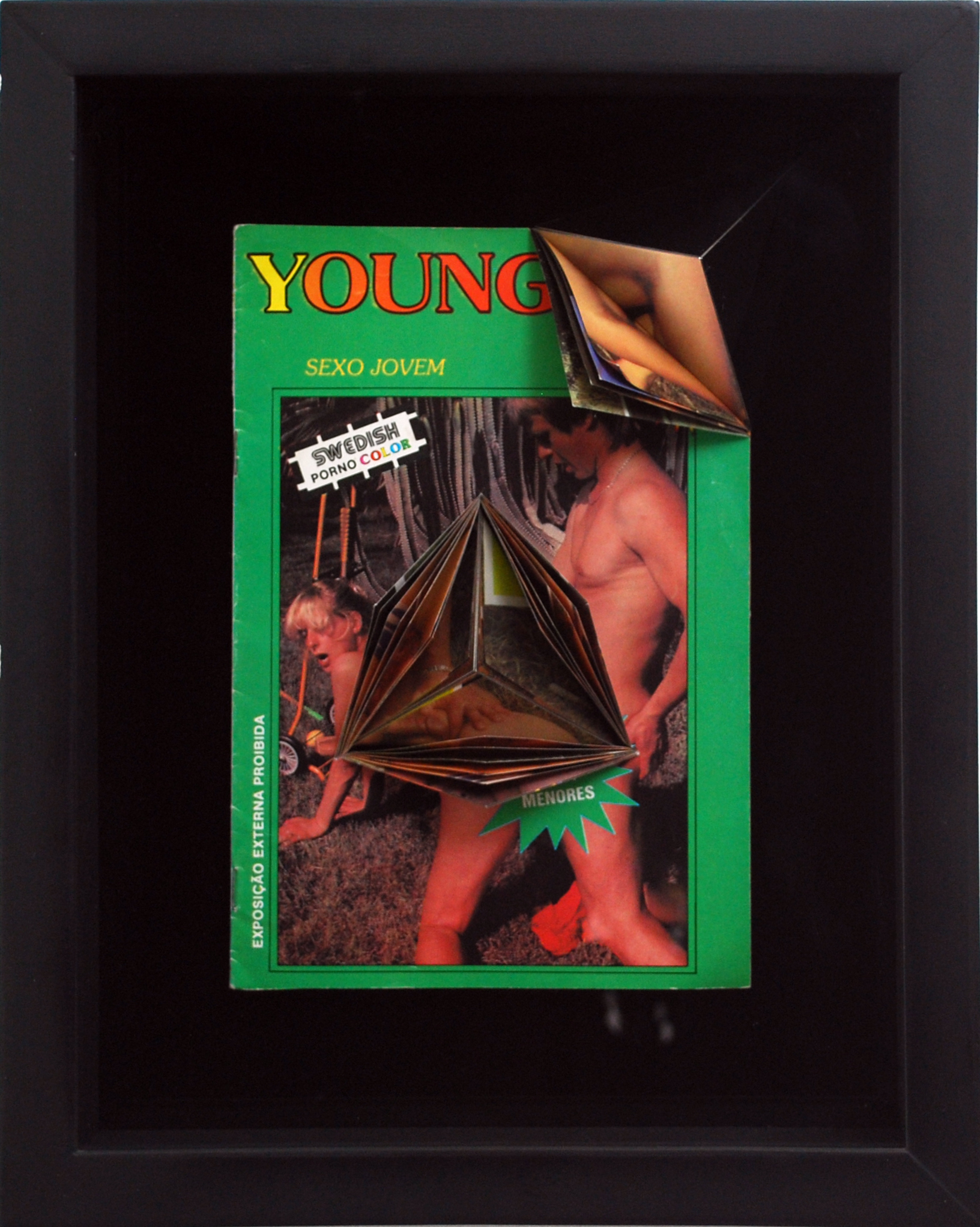
autorretrato [young sex], 2010
self-portrait [young sex], 2010
intervenção em revista
sliced magazine and stainless steel
36 x 28 cm
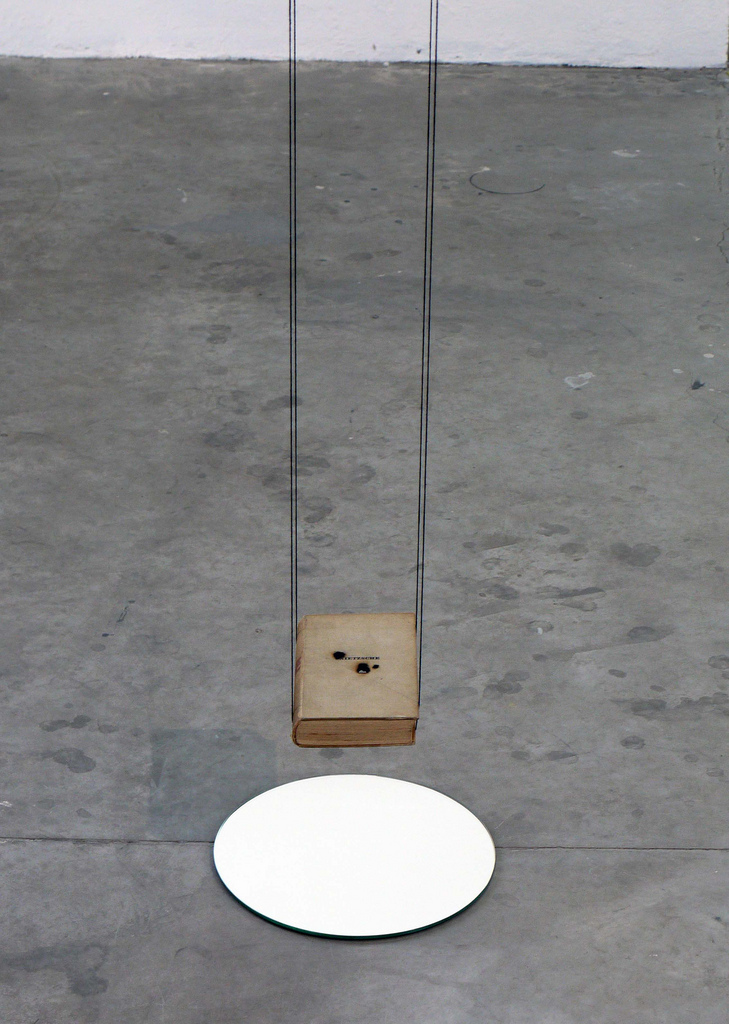
nietszche
livro queimado, espelho e linha
burned book, mirror and line
13x 21 cm (altura variável - variable height)
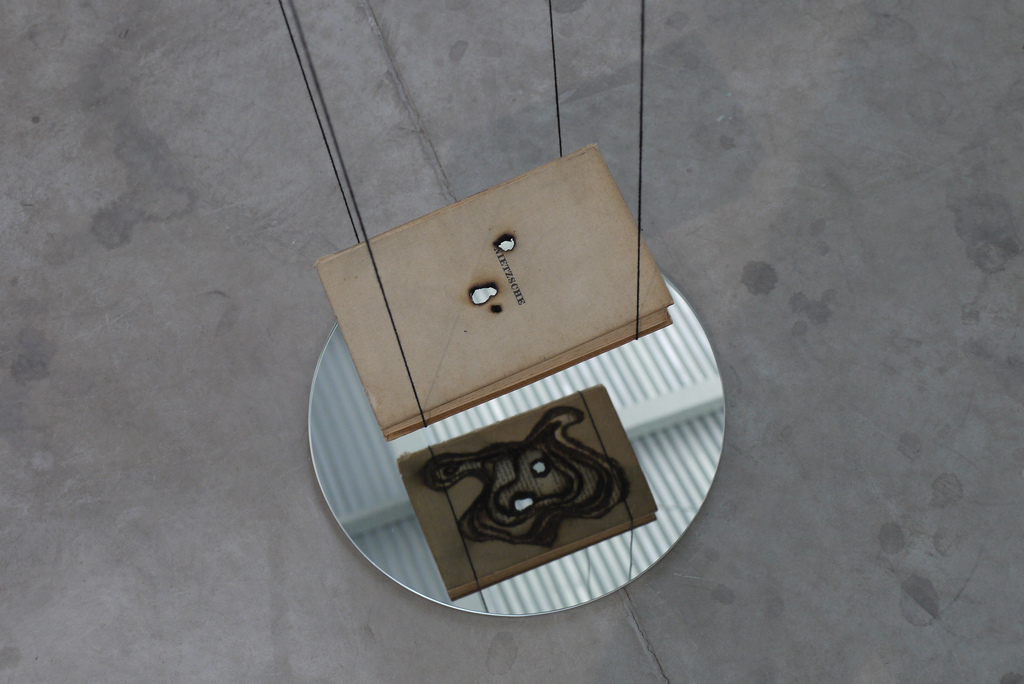
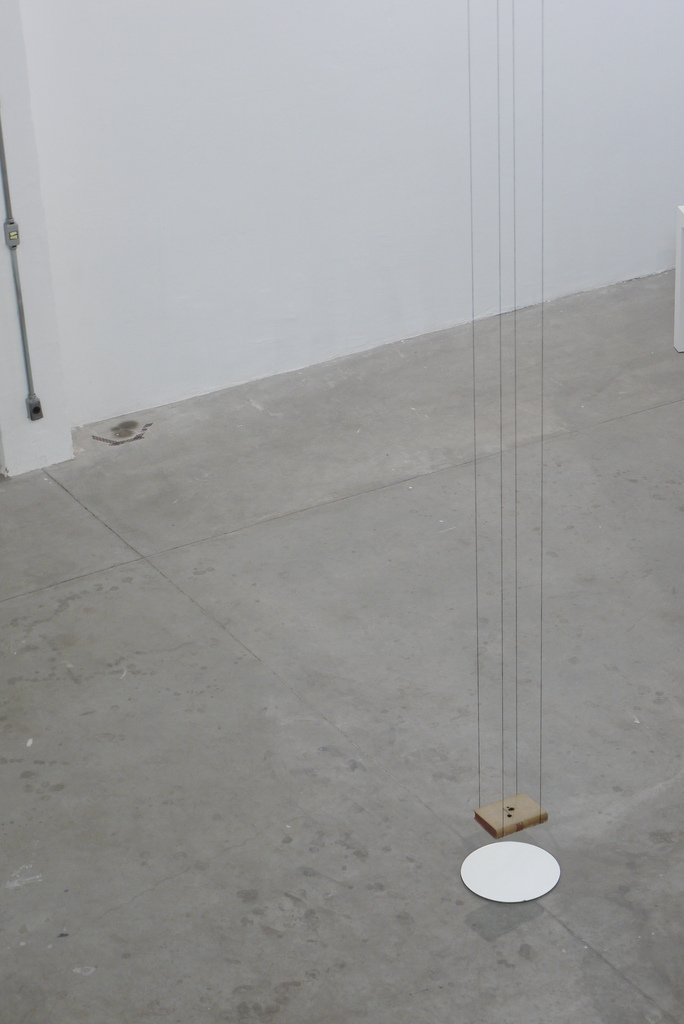
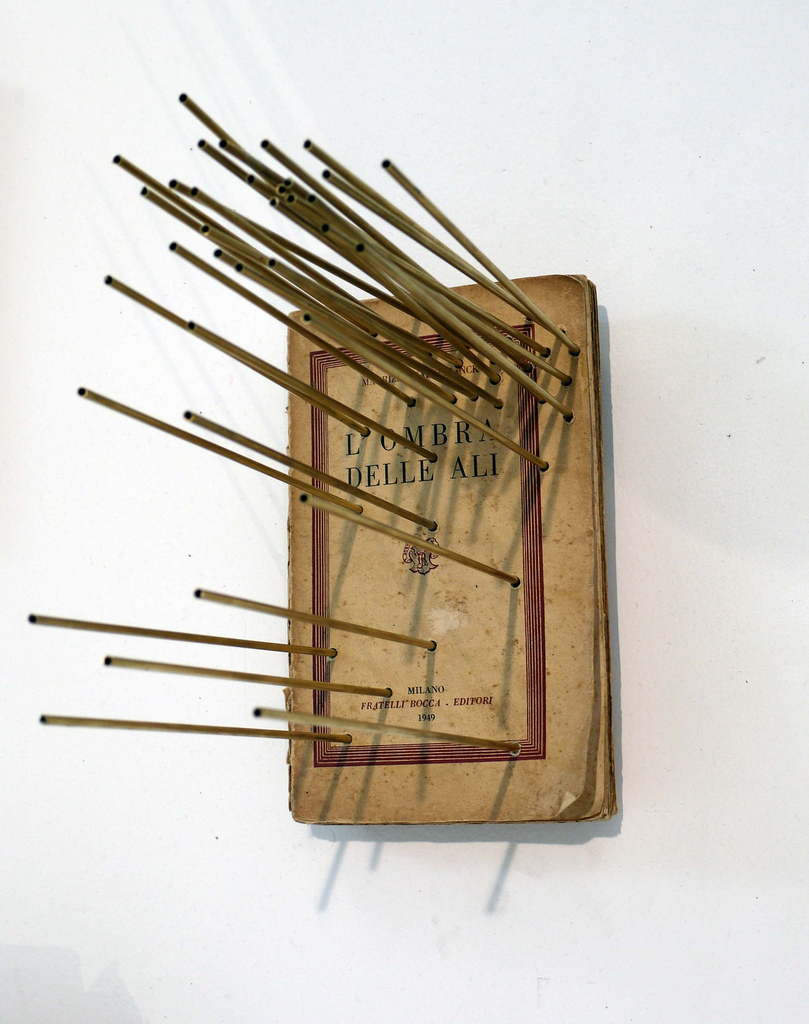
l`ombra delle ali
intervenção em livro
sliced book and metal tubes
variable [21 x 15 cm]
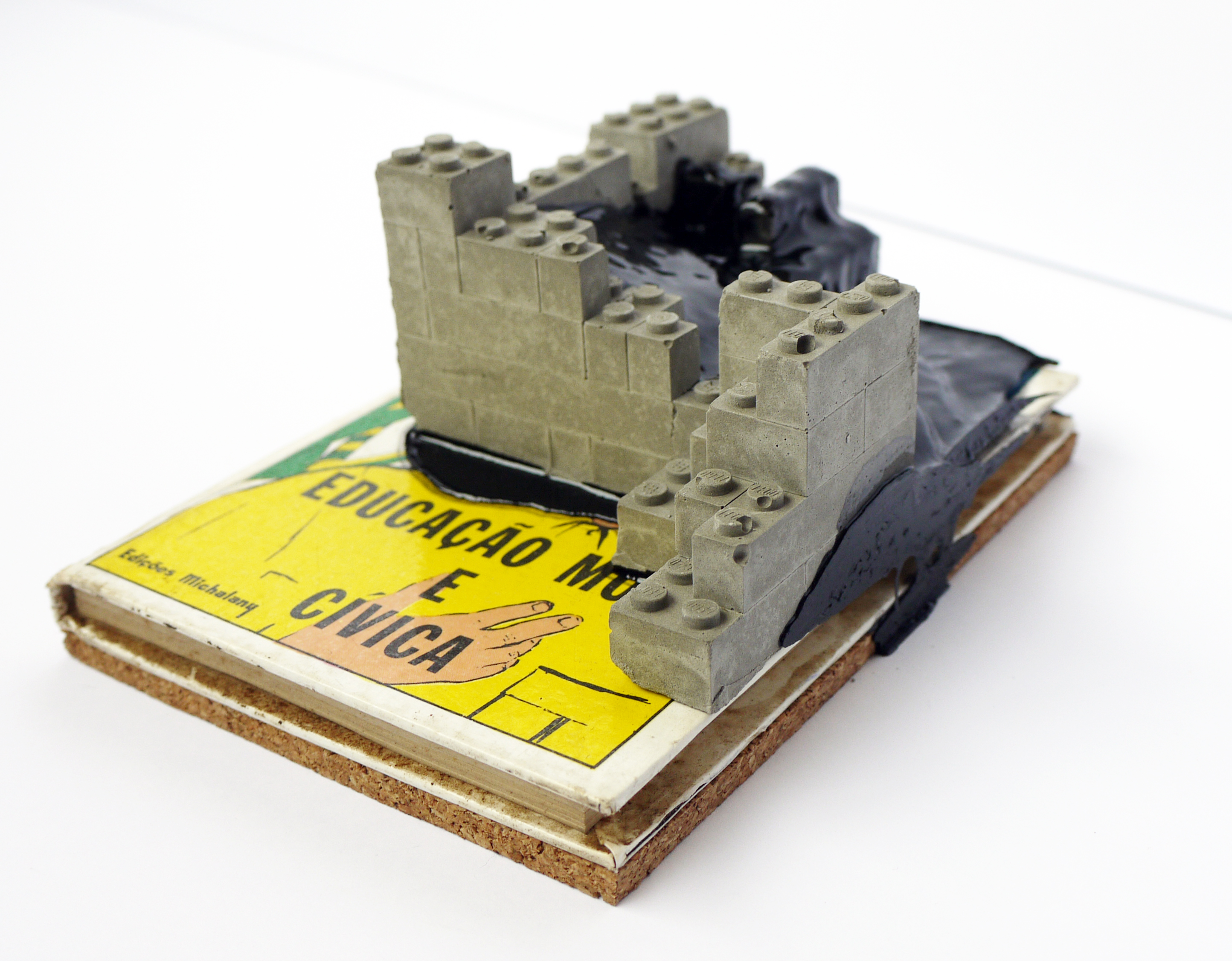
educação moral e cívica, 2011
moral and civid education, 2011
livro, concreto, resina e cortiça
book, concrete, resin and cork
7 x 11 x 16 cm


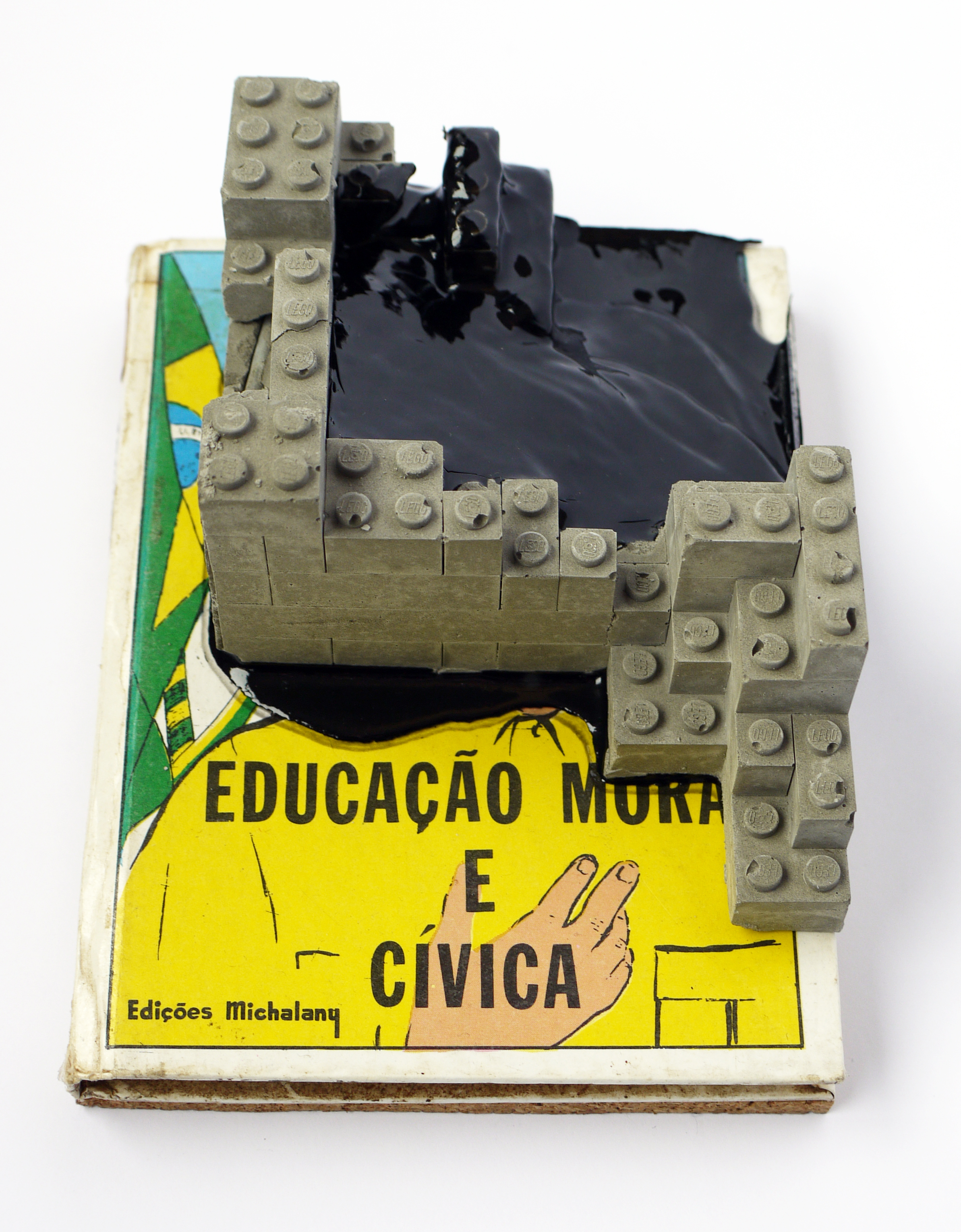
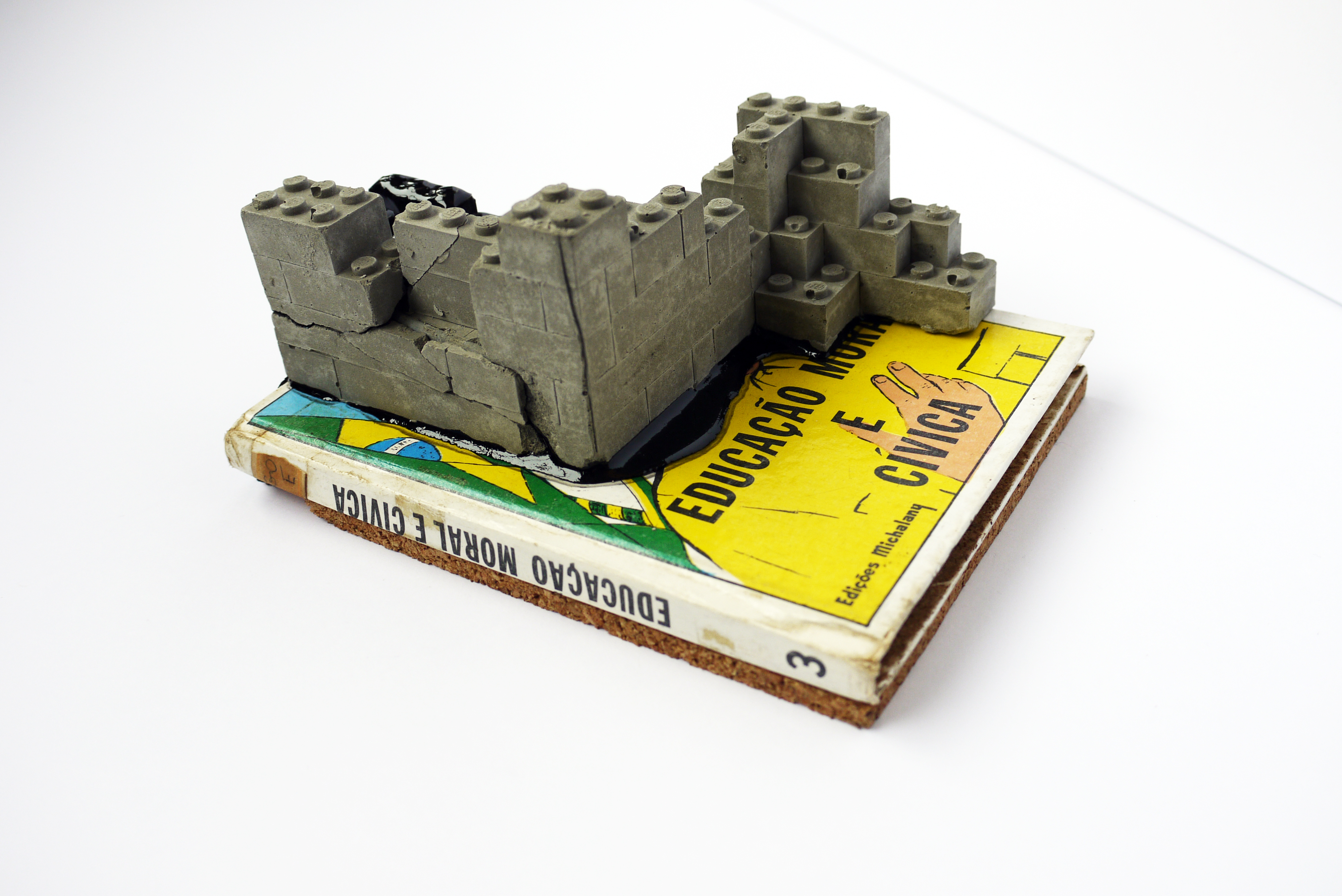
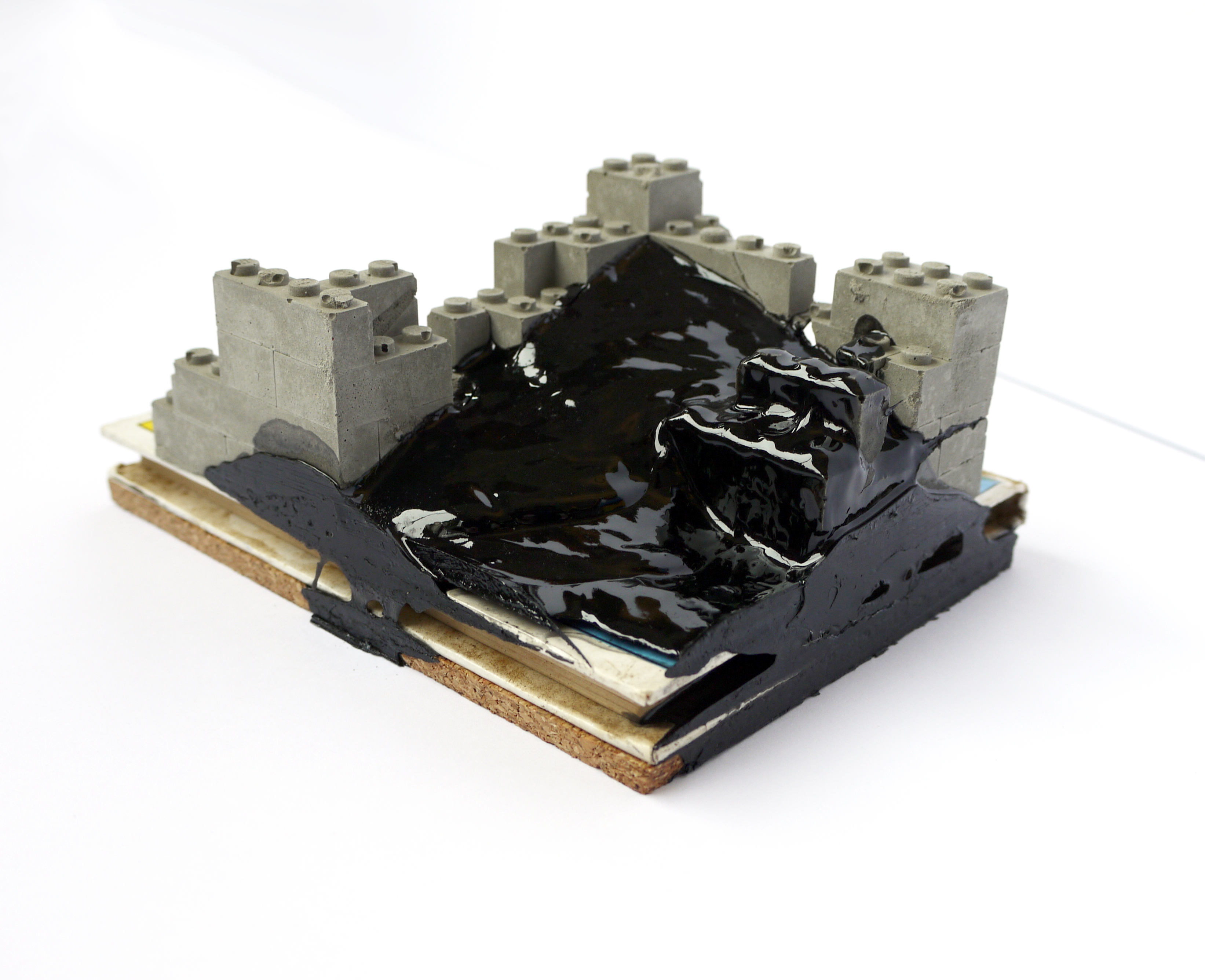
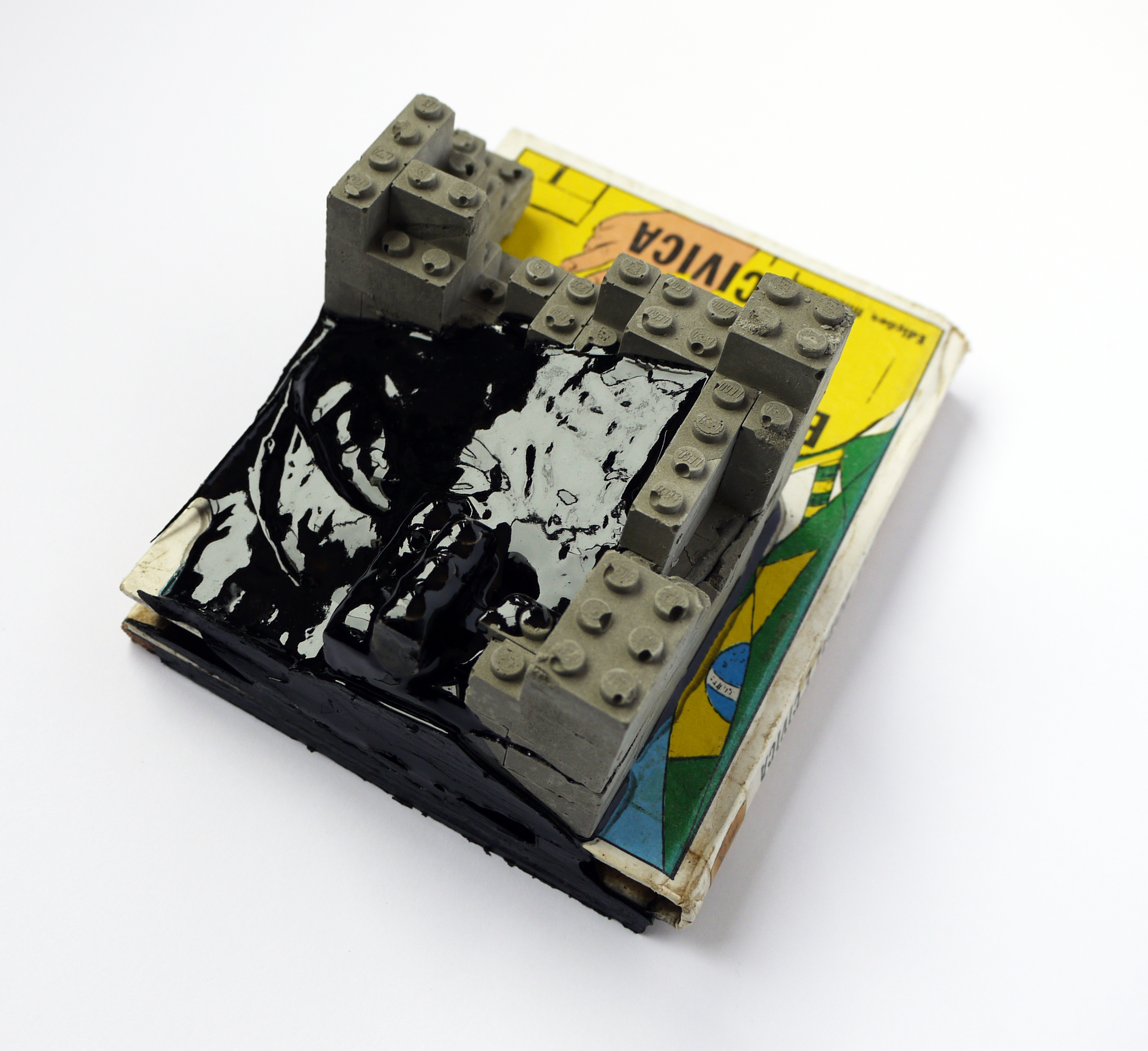

como chama o nome disso, 2012
e (esse pedaço de papel escrito amor) -
sem palavras
... pois é mesmo dura
leva muito tempo?
de terra? vento?
livro, silicone e alfinetes
book, silicone and pins
40 x 21 cm

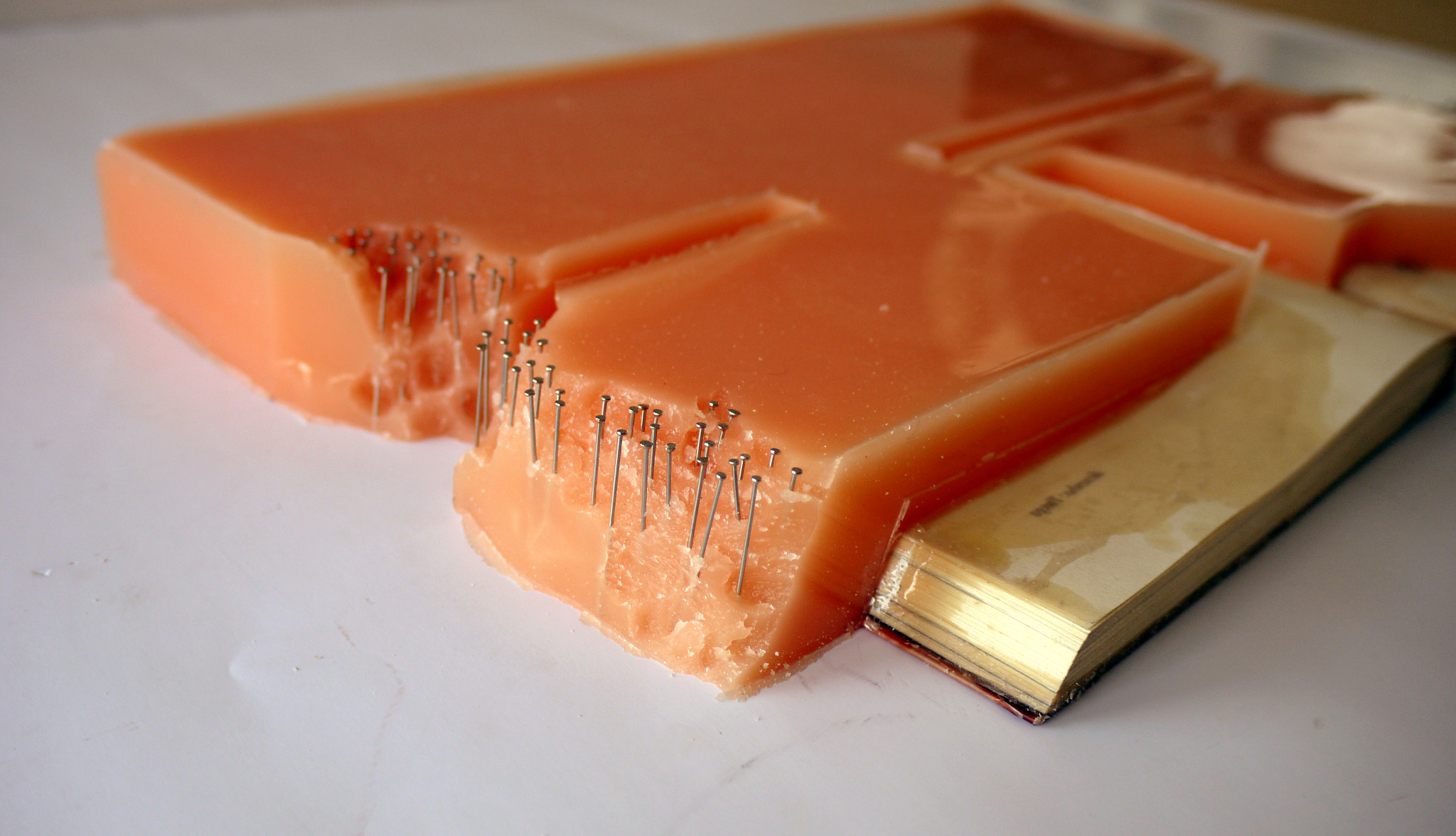
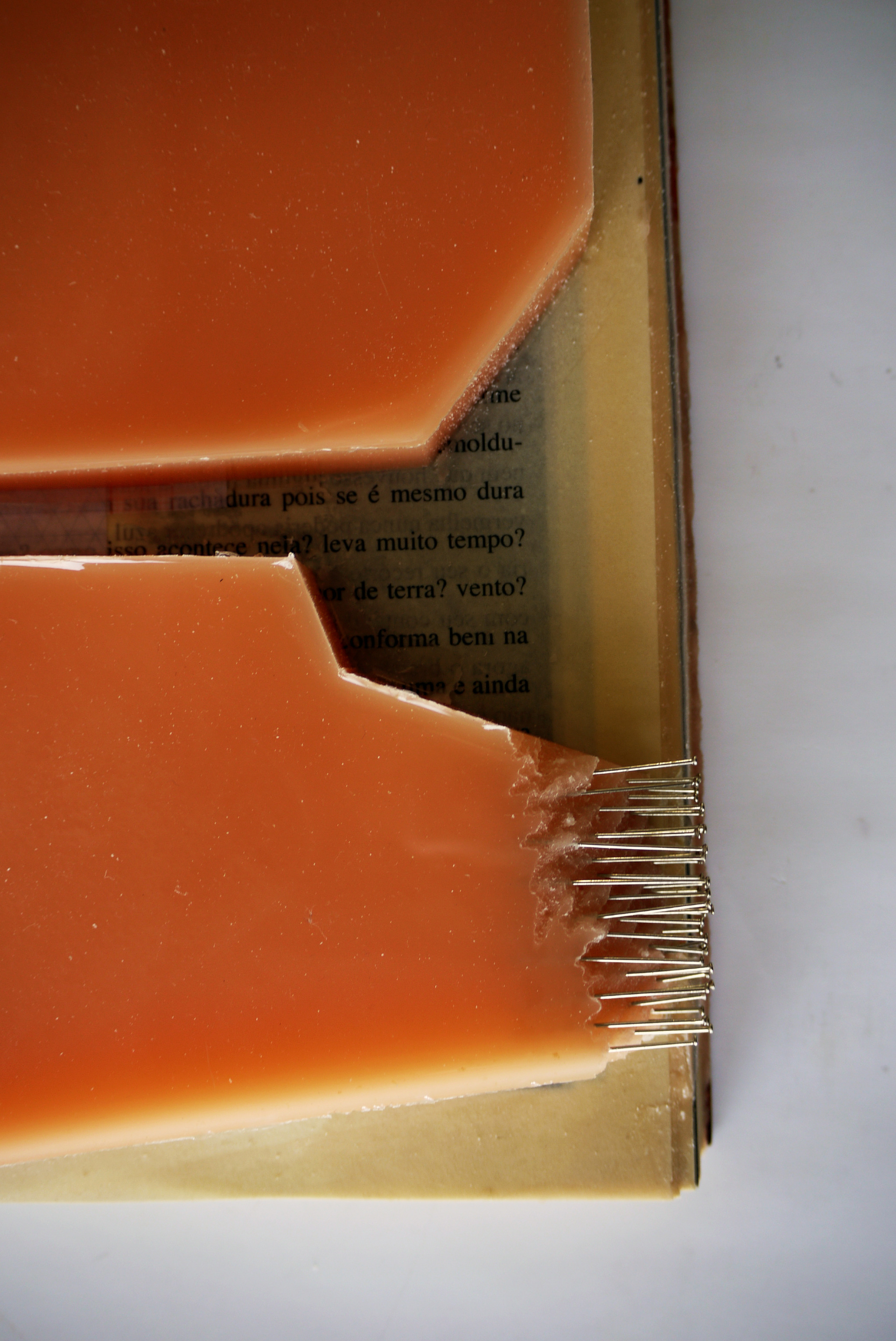

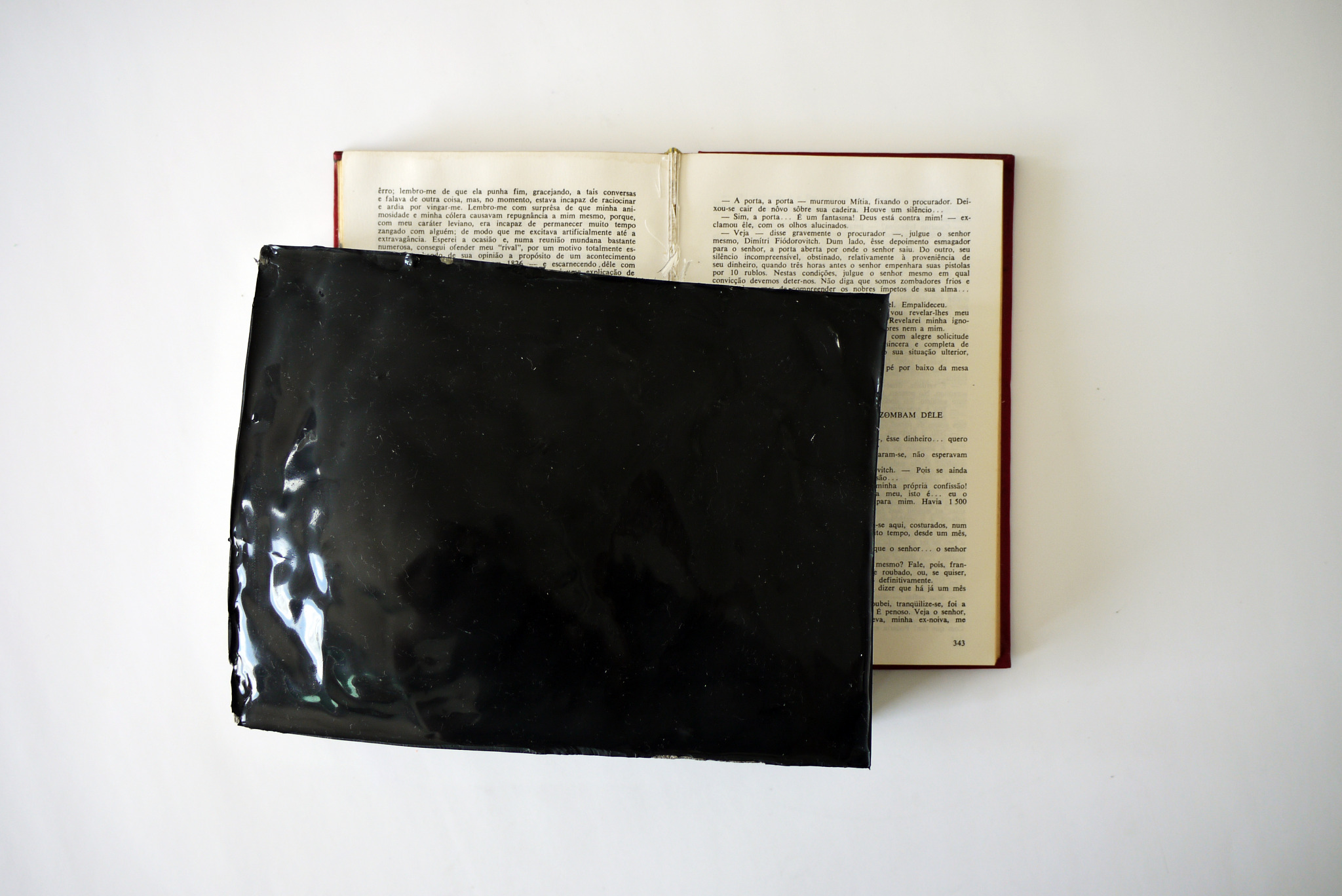
irmãos karamázov, os
livro, cimento e silicone
book, cement and silicone
27 x 27 cm

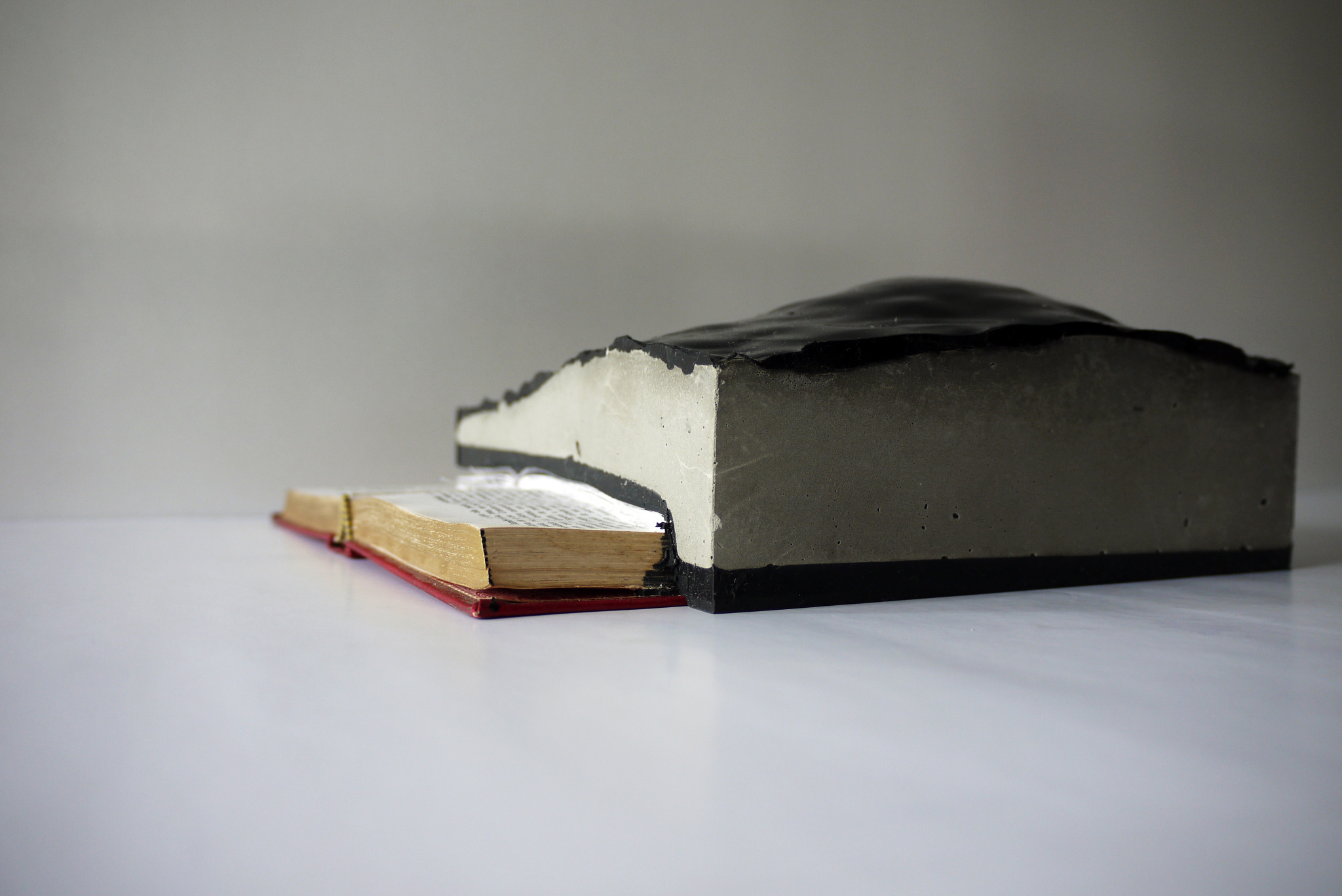


O desenvolvimento da Imaginação
sobre o tempo e a memória,
o que fica, o que se perde, 2012
livro e silicone
book and silicone
30 x 40 x 4 cm


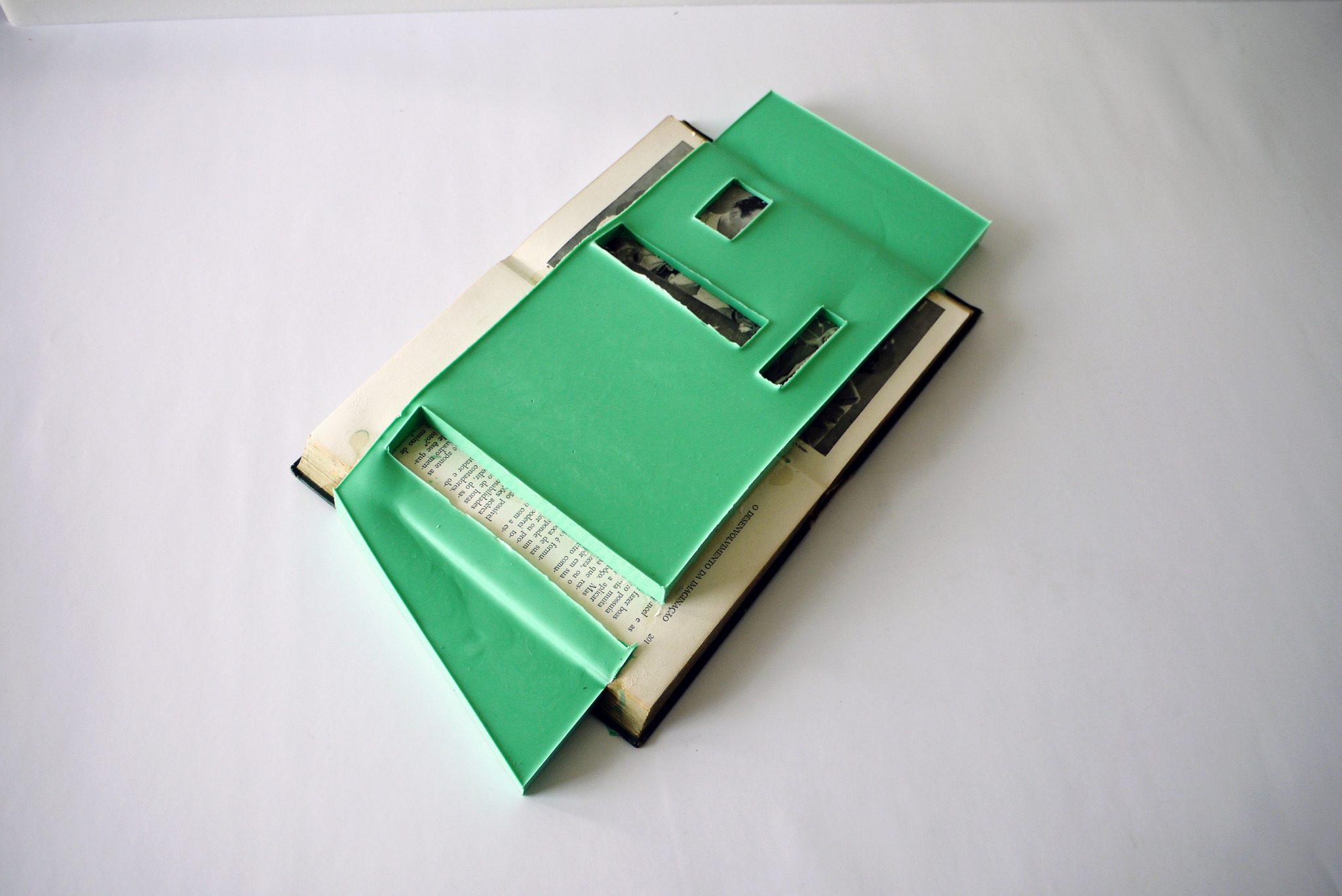

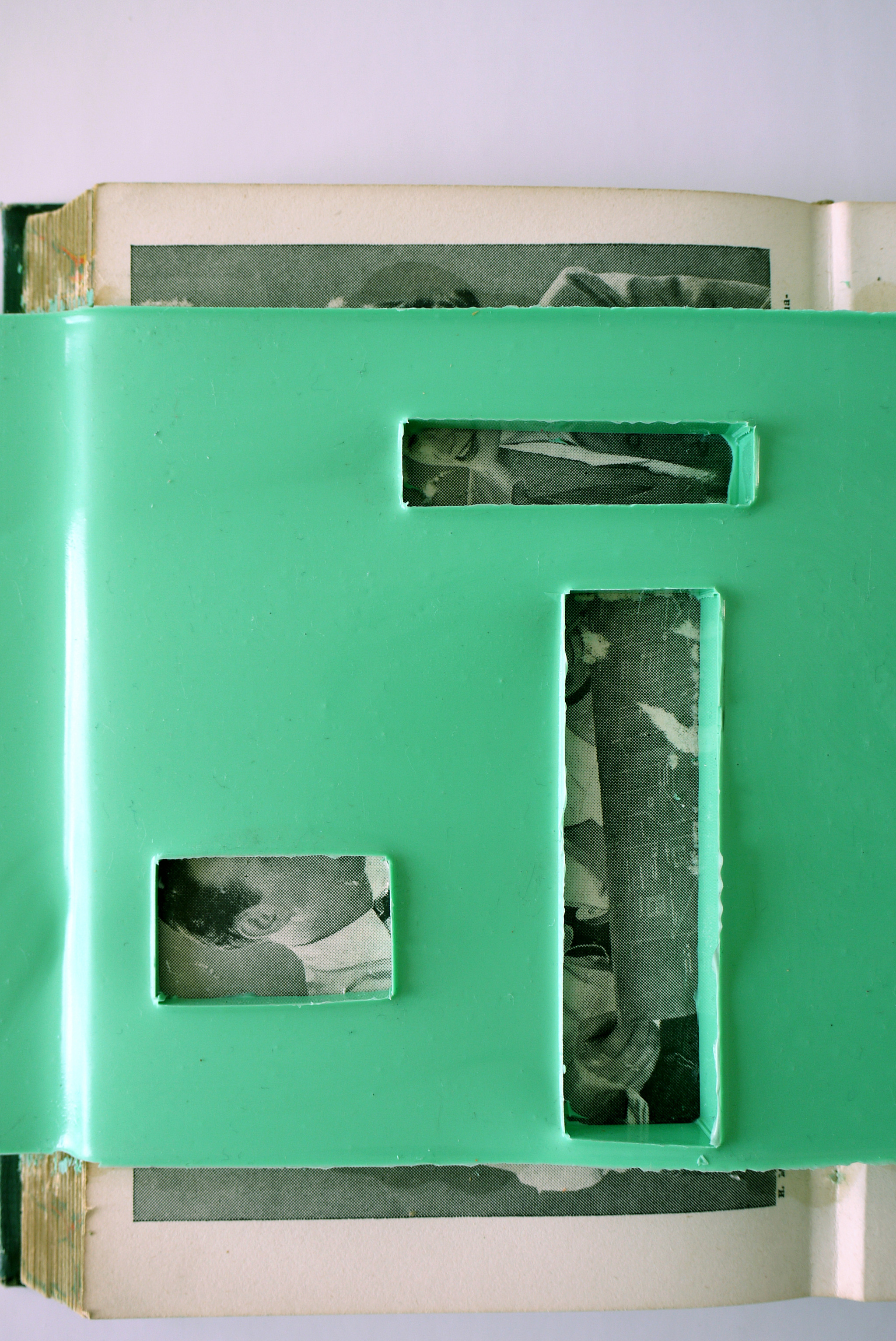
toi et moi, 2012
you and me, 2012
livro,vidro e linha
book, glass and thread
15 x 21 x 16 cm
Texto em português
Após um breve e vertiginoso estranhamento se torna visível o gesto preciso de Lucas Simões para interferir no livro Tendências da Escultura Moderna, de Walter Zanini, e assim gerar sua ressignificação: uma leitura por desmanche. Foi suficiente um corte diagonal e o deslocamento de um dos módulos resultantes até a lombada para que o artista rearticulasse tanto o volume do livro quanta o campo discursivo a que se refere sua pesquisa. Essa reconfiguração reafirma
e desdobra o corte inaugural, que passa a delimitar as laterais do livro e garante que se instale uma cisão no centro do objeto. O livro parece perspectivado no plano e a leitura de seu conteúdo drasticamente interditada pela interrupção que o atravessa por inteiro. Ainda que preserve simetria, esta não e imediata nem evidente, ao contrário, pelas formas angulares cria-se oscilação e descontinuidade em nosso olhar. Este aparente desequilíbrio garante certa carga expressiva ao arranjo, a despeito de sua coerência geométrica, e neste sentido nos lembra recursos compositivos de algumas obras neoconcretas, tributarias de uma vontade de ampliar e mesmo romper com algumas das tendências que se estabeleceram como vocabulário formal da arte moderna. Os Metaesquemas, de Hélio Oiticica, por exemplo, testemunham em fins da década de 1950 um esforço em tensionar a estrutura da grade modernista e aderir elementos da subjetividade ao vocabulário geométrico rigoroso da arte concreta, construindo uma geometria sensível, porosa a contaminação com outros campos interpretativos da forma. Nessas obras, o equilíbrio conquistado pelas formas se estabeleceu por vias desiguais, a custo de interferências, desvios e intervalos nos limites ortogonais, fazendo surgir dinâmica e musicalidade imprevistas. Ha no livro-objeto de Lucas Simoes um desejo parecido de manipular formas e rearticular significados a partir de deslocamentos simples, mas que revelam a dimensão crítica que essas instancias podem adquirir em diferentes situações. Torna-se palpável a consciência de que cada elemento da obra - o corte diagonal, a recomposição formal do volume, a apropriação do livro e de sua temática, a proposta de um atravessamento em sua leitura - e gerido pelo artista de modo a potencializar suas múltiplas possibilidades semânticas. Entre (re)leitura crítica da história da escultura e ‘procedimento escultórico’, o corte realizado intervém tanto no volume do livro quanto em sua dimensão simbótica e, assim, constitui e propõe uma estratégia de assimilação e uso criativo dos recursos disponibilizados pela história da arte, especificamente no
campo da escultura (por sinal, aquele em que as especificidades do meio foram mais expandidas, obscurecidas e problematizadas pelas praticas dos artistas, sobretudo a partir de meados dos a nos 1960). O discurso da história da arte, com efeito, e assumido no trabalho como materialidade a ser interferida, moldada e reapresentada pelo artista. Assim, todos os repertórios estudados e analisados por Walter Zanini em seu livro, desde certo conservadorismo que o autor identifica na escultura de fins do século XIX até os experimentos mais radicais e inte grados ao espírito das vanguardas do começo do século XX, como o readymade duchampiano, por exemplo (cuja ressonância se faz sentir na apropriação e retificação do objeto articulados por Lucas Simões), são convocados na leitura que o artista objetifica em sua obra. Daí entender forma e gesto como discurso crítico: a leitura por desmanche propõe mobilizar ativamente o legado da história da arte, capacitando e promovendo novas legibilidades de seus registros.
texto de Julio Martins
parte da publicação: " Acervo: Outras Abordagens, vol.2, MAC Essencial)
Quase trinta a nos após ser publicado, um livro sobre a história da escultura moderna e cortado ao meio, incorporando-se ele mesmo a essa história.
A operação de Lucas Simões surge de um talhe rápido e seco em diagonal, recompondo-se as duas partes cindidas em outro objeto. O artista prolonga e atualiza, desse modo, um gesto como o de Lucio Fontana, com seu rasgo cirúrgico e lacônico que resulta em múltiplos significados. Mas se na obra de Fontana os suportes artísticos tradicionais e a história
da arte são confrontados, em Tendências da Escultura Moderna, de forma complementar, abrange-se o estatuto da mídia impressa em tempos de digitalização. Os sentidos de Tendências também se ampliam por ela pertencer ao acervo do MAC USP: tanto por ter sido Walter Zanini, autor do livro, o primeiro diretor da instituição quanto por trazer estampadas
na capa as esculturas de Max Bill e Umberto Boccioni, Unidade Tripartida e Formas Únicas de Continuidade no Espaço, ambas igualmente do museu. Podemos nos perguntar também sobre o “acaso” de a imagem do homem de Formas Únicas ser decepada pela divisão da brochura, e do seu andar oblíquo coincidir com a geratriz formal do novo volume,
dando-lhe continuidade e impulso. Seria casual ainda que a geometria desse novo volume possa evocar o concretismo dos anos em que Zanini concebeu o livro?
Sendo substancialmente ambígua, a operação de Simões ultrapassa a mera iconoclastia para se constituir num fruto duchampiano legítimo. Sua simplicidade, para além do minimalismo, manifesta-se também na manutenção do título original, constituindo-se de modo simultâneo em reverencia e superação. Incisiva como o golpe que a gerou, Tendências da Escultura Moderna não carece de longa contemplação. Mas se o olhar se fecha como guilhotina, e impossível vislumbrar-lhe um valor, assentado especialmente no tempo. Basta olhar para o miolo branco que surge com o corte diagonal no livro, em contraste com o amarelado das bordas, para compreender que os anos, indiferentes, agem sobre todos.
texto de Alex Miyoshi
parte da publicação: " Acervo: Outras Abordagens, vol.3, MAC Essencial)
Após um breve e vertiginoso estranhamento se torna visível o gesto preciso de Lucas Simões para interferir no livro Tendências da Escultura Moderna, de Walter Zanini, e assim gerar sua ressignificação: uma leitura por desmanche. Foi suficiente um corte diagonal e o deslocamento de um dos módulos resultantes até a lombada para que o artista rearticulasse tanto o volume do livro quanta o campo discursivo a que se refere sua pesquisa. Essa reconfiguração reafirma
e desdobra o corte inaugural, que passa a delimitar as laterais do livro e garante que se instale uma cisão no centro do objeto. O livro parece perspectivado no plano e a leitura de seu conteúdo drasticamente interditada pela interrupção que o atravessa por inteiro. Ainda que preserve simetria, esta não e imediata nem evidente, ao contrário, pelas formas angulares cria-se oscilação e descontinuidade em nosso olhar. Este aparente desequilíbrio garante certa carga expressiva ao arranjo, a despeito de sua coerência geométrica, e neste sentido nos lembra recursos compositivos de algumas obras neoconcretas, tributarias de uma vontade de ampliar e mesmo romper com algumas das tendências que se estabeleceram como vocabulário formal da arte moderna. Os Metaesquemas, de Hélio Oiticica, por exemplo, testemunham em fins da década de 1950 um esforço em tensionar a estrutura da grade modernista e aderir elementos da subjetividade ao vocabulário geométrico rigoroso da arte concreta, construindo uma geometria sensível, porosa a contaminação com outros campos interpretativos da forma. Nessas obras, o equilíbrio conquistado pelas formas se estabeleceu por vias desiguais, a custo de interferências, desvios e intervalos nos limites ortogonais, fazendo surgir dinâmica e musicalidade imprevistas. Ha no livro-objeto de Lucas Simoes um desejo parecido de manipular formas e rearticular significados a partir de deslocamentos simples, mas que revelam a dimensão crítica que essas instancias podem adquirir em diferentes situações. Torna-se palpável a consciência de que cada elemento da obra - o corte diagonal, a recomposição formal do volume, a apropriação do livro e de sua temática, a proposta de um atravessamento em sua leitura - e gerido pelo artista de modo a potencializar suas múltiplas possibilidades semânticas. Entre (re)leitura crítica da história da escultura e ‘procedimento escultórico’, o corte realizado intervém tanto no volume do livro quanto em sua dimensão simbótica e, assim, constitui e propõe uma estratégia de assimilação e uso criativo dos recursos disponibilizados pela história da arte, especificamente no
campo da escultura (por sinal, aquele em que as especificidades do meio foram mais expandidas, obscurecidas e problematizadas pelas praticas dos artistas, sobretudo a partir de meados dos a nos 1960). O discurso da história da arte, com efeito, e assumido no trabalho como materialidade a ser interferida, moldada e reapresentada pelo artista. Assim, todos os repertórios estudados e analisados por Walter Zanini em seu livro, desde certo conservadorismo que o autor identifica na escultura de fins do século XIX até os experimentos mais radicais e inte grados ao espírito das vanguardas do começo do século XX, como o readymade duchampiano, por exemplo (cuja ressonância se faz sentir na apropriação e retificação do objeto articulados por Lucas Simões), são convocados na leitura que o artista objetifica em sua obra. Daí entender forma e gesto como discurso crítico: a leitura por desmanche propõe mobilizar ativamente o legado da história da arte, capacitando e promovendo novas legibilidades de seus registros.
texto de Julio Martins
parte da publicação: " Acervo: Outras Abordagens, vol.2, MAC Essencial)
Quase trinta a nos após ser publicado, um livro sobre a história da escultura moderna e cortado ao meio, incorporando-se ele mesmo a essa história.
A operação de Lucas Simões surge de um talhe rápido e seco em diagonal, recompondo-se as duas partes cindidas em outro objeto. O artista prolonga e atualiza, desse modo, um gesto como o de Lucio Fontana, com seu rasgo cirúrgico e lacônico que resulta em múltiplos significados. Mas se na obra de Fontana os suportes artísticos tradicionais e a história
da arte são confrontados, em Tendências da Escultura Moderna, de forma complementar, abrange-se o estatuto da mídia impressa em tempos de digitalização. Os sentidos de Tendências também se ampliam por ela pertencer ao acervo do MAC USP: tanto por ter sido Walter Zanini, autor do livro, o primeiro diretor da instituição quanto por trazer estampadas
na capa as esculturas de Max Bill e Umberto Boccioni, Unidade Tripartida e Formas Únicas de Continuidade no Espaço, ambas igualmente do museu. Podemos nos perguntar também sobre o “acaso” de a imagem do homem de Formas Únicas ser decepada pela divisão da brochura, e do seu andar oblíquo coincidir com a geratriz formal do novo volume,
dando-lhe continuidade e impulso. Seria casual ainda que a geometria desse novo volume possa evocar o concretismo dos anos em que Zanini concebeu o livro?
Sendo substancialmente ambígua, a operação de Simões ultrapassa a mera iconoclastia para se constituir num fruto duchampiano legítimo. Sua simplicidade, para além do minimalismo, manifesta-se também na manutenção do título original, constituindo-se de modo simultâneo em reverencia e superação. Incisiva como o golpe que a gerou, Tendências da Escultura Moderna não carece de longa contemplação. Mas se o olhar se fecha como guilhotina, e impossível vislumbrar-lhe um valor, assentado especialmente no tempo. Basta olhar para o miolo branco que surge com o corte diagonal no livro, em contraste com o amarelado das bordas, para compreender que os anos, indiferentes, agem sobre todos.
texto de Alex Miyoshi
parte da publicação: " Acervo: Outras Abordagens, vol.3, MAC Essencial)
